« June 2006 | Main | August 2006 »
July 31, 2006
Oribotics
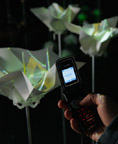
Folding and Unfolding on Command
Oribotics--by Matthew Gardiner--is the fusion of origami and technology, specifically 'bot' technology, such as robots, or intelligent computer agents known as bots. The system was designed to create an intimate connection between the audience and the bots; a cross between gardening, messaging a friend, and commanding a robot. It was developed during an Australian Network for Artists and Technology (ANAT) artists lab; achieved with Processing as an authoring tool, and connected a mobile phone via a USB cable.
"Ori-botics is a joining of two complex fields of study. Ori comes from the Japanese verb Oru literally meaning 'to fold'. Origami the Japanese word for paper folding, comes from the same root. Oribotics is origami that is controlled by robot technology; paper that will fold and unfold on command.
An Oribot by definition is a folding bot. By this definition, anything that uses robotics/botics and folding together is an oribot. This includes some industrial applications already in existance, such as Miura's folds taken to space, and also includes my two latest works. Orimattic, and Oribotics." [via textually.org]
Posted by jo at 06:10 PM | Comments (0)
Freq2
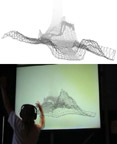
Body as Audible Instrument within Sonic Composition
Freq2, by Squidsoup, uses your whole body to control the precise nature of a sound – a form of musical instrument. The mechanism used is to trace the outline of a person’s shadow, using a webcam, and transform this line into an audible sound. Any sound can be described as a waveform – essentially a line – and so these lines can be derived from one’s shadow. What you see is literally what you hear, as the drawn wave is immediately audible as a realtime dynamic drone.
Freq2 adds to this experience by adding a temporal component to the mix; a sonic composition in which to frame the instrument. The visuals, an abstract 3-dimensional landscape, extrudes in realtime into the distance, leaving a trail of the interactions that have occurred. This ‘memory’ of what has gone before is reflected in the sounds, with long loops echoing passed interactions. The sounds, all generated in realtime from the live waveform, have also been built into more of a compositional soundscape, with the waveform being played at a range of pitches and with a rhythmic component.
Watch video. Freq2 was commissioned for Cybersonica 06 and shown, as part of Cybersonica 06, at various venues across the UK including Tate Britain, Dana Centre, Phonica and b-tween (National Museum of Photography, Film and Television). More from Squidsoup: Altzero, Come Closer, Doodle. More from Cybersonica 06. [blogged by Chris on Pixelsumo]
Posted by jo at 05:51 PM | Comments (0)
The Other India
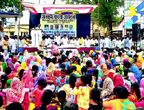
100,000 Farmer Suicides
"The Vidarbha Jan Andolan Samiti has put up a blog as part of its campaign for statehood for Vidarbha as also the continuing farmers' suicides. Amongst other things there is a list of names of 655 farmers who have committed suicide since June 2005. A group of farmers is planning a march to Delhi on 15 August.
Imagine such a large number of people committing suicide in any other profession - say, in the BPO industry - and imagine our response. It would be frontpage news in all national papers. It would occupy far more air time than on TV than what the continuing agricultural crisis in Vidarbha and Telangana is currently getting. There would be dedicated "campaigns" and people across the country would be sending money to the Prime Minister's Relief Fund. Ordinary people would come out to their rescue, companies would announce relocation packages.
Between 1993 and 2003, a hundred thousand farmers in India have killed themselves, largely due to debt. Whether it is state control and lack of competition or the lessening of state support to agriculture that has caused the crisis is open for the ideological jury. What cannot be disputed is that it is a national shame and deserves far more attention from all of us.
There is a lot to talk about what's happening in Vidarbha, and a lot is controversial. Bt Cotton, cotton subsidies in the west, the reduction of minimum support price by the government, the government's suicide compensation as an incentive to commit suicide, the state control over agriculture [...] Whatever the reasons and debates be, the suicides must stop, and they must stop now. I urge those of you in the media to give the subject a lot more attention, and bloggers and writers to write about it. Also see The Other India" [posted by Shivam Vij on Sarai]
Posted by jo at 03:05 PM | Comments (0)
ArtCamp: The Un-Conference

NO SPECTATORS, ONLY PARTICIPANTS
ArtCamp is the World's First un-Conference on Art. We are calling it an un-conference, but you can also think of it as a BarCamp about Art, a gathering that uses Open Space Technology, an Open-Source Conference, or just as an opportunity to get together during the New Forms Festival in Vancouver on September 21, 2006 to meet, greet, learn, collaborate, mashup, and share practices and ideas about art, media, networks and technology.
NO SPECTATORS, ONLY PARTICIPANTS :: It is an intense event with discussions, demos and interaction from attendees. Anyone with something to contribute or with the desire to learn is welcome and invited to join. hen you come, be prepared to share with artcampers. When you leave, be prepared to share it with the world. Attendees must give a demo, a session, or help with one, or otherwise volunteer / contribute in some way to support the event. All presentations are scheduled the day they happen. Prepare in advance, but come early to get a slot on the wall. The people who are present at the event will select the demos or presentations they want to see. ArtCamp is free and open to everyone but you must sign up on the Wiki.
ArtCamp is co-presented by Upgrade! Vancouver and the New Forms Festival. For more information email Kate Armstrong kate[at]katearmstrong.com
Posted by jo at 12:51 PM | Comments (0)
Locus Sonus Audio Streaming Project
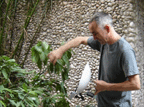
OPEN CALL
August 2006 :: This is a call from the French based Audio in art research group Locus Sonus to participate in their streamed soundscapes open web-mike project. Open an ogg audio stream from your home or garden (no pre-recorded playlists please) and become a remote member of the Locus Sonus orchestra.
Locus Sonus is a research group specialized in audio art (École Supérieure d'Art d'Aix-en-Provence, École Nationale Supérieure d'Art de Nice Villa Arson). Its objective is to experiment and evaluate the innovative and transdisciplinary nature of audio art forms in a lab-type context. It is also concerned with in the communal, collective or multi-user aspects inherent in many emerging audio practices and which necessitate working as a group. Two main thematics define this research - audio in it's relation to space and networked audio systems.
To participate in this project, contact support[at]locusonus.org :: to listen to the streams already available click here :: to download a PD patch and start streaming click here :: to see video documentation of our previous presentations and to find out more about Locus Sonus in general, click here.
NEXT PUBLIC EVENTS
Presentations start from 15th to 30th of August in various performance and installation situations, starting with DIGIT Delaware Delaware Valley Arts Alliance & Roebling Bridge Environmental Arts and LMCC (Lower Manhattan Cultural Council) in partnership with THE THING Inc. (New York) with the support of Étant Donnés, The French-American Fund for Contemporary Art.
Presentations continue in the fall with an installation during the Arborescence festival in Aix-en-Provence, France, and an installation performance at GMEM, Marseille France.
Festival DIGIT: http://www.artsalliancesite.org/programs/digit_06.html
LMCC: http://www.lmcc.net/
THE THING: http://bbs.thing.net/
Arborescence: http://www.arborescence.org/rubrique.php3?id_rubrique=3
GMEM: http://www.gmem.org/
TECHNICAL DOC
To Start Streaming You will Need :
* a PC or Mac dedicated to the stream (an old 450 MHz machine should do).
* a sound card recognized by your operating system.
* a microphone ($3 radioshack mike is fine).
* streaming software (we propose that you download our PD patch and run it using PureData that way you can customize your stream (for OSX, Windows and Linux). We recommend that you use this Hans Christoph Steiner's extended version which includes the necessary ogg vorbis libraries.
* a high speed internet connection and a network router.
We obtained the good results using the Dyne:bolic Linux distribution. The advantage being thats it's a liveCD (so you don't have to install the system) and that PD and all the necessary externals are already installed. You might run into difficulties if the system doesn't recognize the PCs built in sound card in which case the easiest option is to find an old soundblaster card and disactivate the built-in card in the bios.
It's important for us to get a wide range of soundscapes and social situations, remember that urban sound is pretty similar around the western world so you might want to chose to place your microphone so as to capture interesting or unique aspects of your environment and also to listen to the other current streams to caracterize yours.
We are also finding that in most circumstances it is preferable to customize the patch, sometimes a little filtering is all thats needed (as for example: port.ogg) but we've also built a sampling patch which records and plays back recent sound events continually updating its database (as for example: cap15.ogg).
Listen to the current streams.
Posted by jo at 10:56 AM | Comments (0)
July 30, 2006
Radio Vehicles
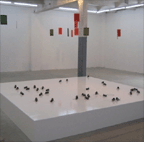
radio.territories urban intervention
Radio Vehicles with Darius James (USA/DE) and Peter Dennett, Art Yard (UK) :: Aliens Am Alex: radio.territories urban intervention at: TV Tower, Alexanderplatz, Berlin :: On Air 95,2 FM or online http://radioeinszueins.de :: July 30, 2006, 16:00 - 18:00.
Apocalypso: The Cosmic War Dance of Sun Ra's Army of Anthropodial Transistors :: When the composer and mystic, Sun Ra, returned to his native Saturn on May 30th, 1993, he left behind him a vast and varied body of recorded musical works. Up until now, much of this music was unreleased and unavailable to the public. But, through a series of séances conducted in the studios of Radio 1:1, with Dr. Snakeskin acting as medium, Mister Ra informed us that he will be returning to this planet in his astral form on Sunday, July 30th, 2006. He will not be alone. He is bringing his army of Anthropoidal Transistors. "We are going to invade Berlin!!!" he chuckled, "Our first target is the TV Tower in Alexanderplatz! My weapons?!! Two full hours of sonic attack—or acoustical magic -- taken from a secret library of unreleased recordings. We will dance a cosmic dance. A cosmic WAR dance. It's the Apocalypso!"
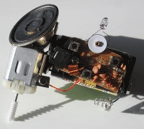
The working environment of the radio vehicles is the urban public space. Radio vehicles is an ephemeral urban intervention aiming to usurp urban space artistically. Twenty vehicles created from simplest and most affordable technical equipment will be let free into the wild. They move about while broadcasting the programme of radio 1:1 which will consist of unpublished Sun Ra material. The swarm moves awkwardly while emitting sound into the public space.
Proudly presented by the bootlab association in cooperation with radio 1:1 as part of the radio.territories series of urban interventions across Europe. Radio.Territories is supported by the European Union Culture 2000 Programme.
Posted by jo at 11:54 AM | Comments (0)
July 28, 2006
Alex Dragulescu

The Architecture of Spam
Alex Dragulescu has some extremely interesting projects up on his website right now. For the most part, they're "experiments and explorations of algorithms, computational models, simulations and information visualizations that involve data derived from databases, spam emails, blogs and video game assets." However, this one – called Spam Architecture – totally blows me away: "The images from the Spam Architecture series are generated by a computer program that accepts as input, junk email. Various patterns, keywords and rhythms found in the text are translated into three-dimensional modeling gestures."
Applying this to large-scale architectural design would be endlessly and hypnotically fascinating – not to mention quite profitable if you turned it into a kind of immersive, 3-dimensional version of Tetris. You turn digital photographs of your last birthday party into architectural structures; your Ph.D. thesis, exported as an inhabitable object; every bank statement you've ever received, transformed into a small Cubist city. Your whole DVD collection, informationally re-presented as a series of large angular buildings.
Of course, you could also reverse the process, and input CAD diagrams of a Frank Gehry building – thus generating an inbox-clogging river of spam email. The Great Wall of China, emailed around the world in an afternoon. The collected works of Frank Lloyd Wright. In any case, Dragulescu currently works at the Experimental Game Lab at UC-San Diego – the same institution at which Sheldon Brown developed his Scalable City project.
(Thanks to Brent Kissel for the tip about Dragulescu – and you can read more here – and to Brian Romer for Scalable City). [blogge by Geoff Manaugh on BLDGBLOG]
Posted by jo at 06:36 PM | Comments (0)
Wald-Forest
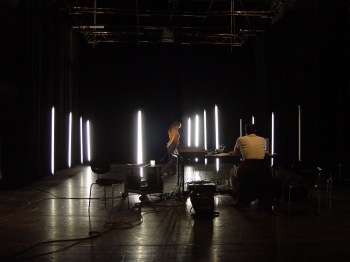
Responsive Architecture + Organism
Wald-Forest by Chris Ziegler :: a forest is both an architecture and also a organism. Forests are areas outside of civilization and human culture, ambivalent places of fears and inspiring fantasies. Wald-Forest is an interactive installation, a performance environment for dance, light, electronic sound and life piano. Neon lamps, hung in a matrix of 16 - 64 units, create a forest-like interactive matrix of light emmitting objects.
The installation is designed to be a light-architecture and also a responisve, digital organism. Moving in it can be as simple and playful as a shadowplay, but there is also disorientation in a matrix of light objects. The indeterminacy of places like this is most interesting to us. Wald-Forest's interactive light and surround sound architecture is related to the movement parameters of the dancer / the audience. The motion tracking parameters are: position and speed of movement.
Wald-Forest defines performative zones by light, shadow and sound. The performer / audience shapes and alters performative acoustic and light - zones by his own movement in realtime. In the live performance we will develop a duet for piano and dance. Real time notation instructions will be sent to the piano player according the dancer‘s movements patterns in space. Composed music parts will interact with algorithms of interactive sound.
concept, director: Chris Ziegler (D)
dance: Christine Bürkle (D)
music: Sandeep Bhagwati (D/IND)
prepared piano: Ernst Surberg (D)
Wald-Forest will be perfomed at Pas de Deux - Dance and New Media Performances, workshops, filmscreenings and interactive installation :: July 29-30 :: Edith Russ Site for Media Art :: Chris Ziegler will be on site for a talk.
The Edith Russ Site for Media Art, the Association for Youth Culture Engagement and the Kulturetage Oldenburg present a series of events which broach the issue of dance and new media. From 28 July until 6 August well known dancers, choreographers and dance companies as well as media artists will give a guest performance. The events will take place at the Edith Russ Site for Media Art and at the Kulturetage Oldenburg. Furthermore workshops will be offered in order to give an impression about dance and new media and to make first experience with "digital dance".
Posted by jo at 11:18 AM | Comments (0)
Raqs Media Collective:

'There Has Been a Change of Plan'
:: Raqs Media Collective: 'There Has Been a Change of Plan' (Selected Works 2002-2006) :: Nature Morte Gallery, A 1 Neeti Bagh, New Delhi :: August 5 - 26, 2006 ::
Sometimes, adjustments have to be made. Schedules need calibration. There are contingencies, questions, obstinate demands, weak excuses, strong desires. You return to the city you never left. You pause, take stock. Sit still and let a conversation begin. Maybe? Around you, aeroplanes sit on wooden platforms in a wilderness like widows on a funeral pyre. Clocks measure fatigue, anxiety and modest epiphanies across latitudes. A door to nowhere stands obstinately against the sky. All your cities are a blur. "Do you like looking at maps?"
Meanwhile, measures are taken, shoes lost and found, ghost stories gather, the city whispers conspiracies to itself, the situation is tense but under control. Someone offers you a postcard. Now: Let's see what happens. Raqs Media Collective is pleased to announce its first solo exhibition in Delhi - 'There Has Been A Change of Plan' at Nature Morte Gallery. The exhibition features selected works (2002 - 2006) in the form of cross media installations with networked computers, objects, postcards, video, sound, prints and projections.
Works exhibited include: 'Lost New Shoes', selections from 'A Measure of Anacoustic Reason', 'Location (n)', '28.28 N / 77.15 E :: 2001/02 (Co-Ordinates of Everyday Life, Delhi 2001-2002)', 'Erosion by Whispers', 'Preface to a Ghost Story' and 'There Has Been a Change of Plan'.
About Raqs Media Collective
(Excerpt from the Wikipedia Entry on Raqs Media Collective): Raqs Media Collective was formed in 1992 by independent media practitioners Jeebesh Bagchi, Monica Narula and Shuddhabrata Sengupta. Based in Delhi, their work engages with urban spaces and global circuits, persistently welding a sharp, edgily contemporary sense of what it means to lay claim to the world from the streets of Delhi. At the same time, Raqs articulates an intimately lived relationship with myths and histories of diverse provenances. Raqs sees its work as opening out a series of investigations with image, sound, software, objects, performance, print, text and lately, curation, that straddle different (and changing) affective and aesthetic registers, expressing an imaginative unpacking of questions of identity and location, a deep ambivalence towards modernity and a quiet but consistent critique of the operations of power and property.
In 2001 Raqs co-founded Sarai at the Centre for the Study of Developing Societies (CSDS) in Delhi where they coordinate media productions, pursue and administer independent research and practice projects and also work as members of the editorial collective of the Sarai Reader series. For Raqs, Sarai is a space where they have the freedom to pursue interdisciplinary and hybrid contexts for creative work and to develop a sustained engagement with urban space and with different forms of media.
Posted by jo at 08:59 AM | Comments (0)
July 27, 2006
The Possible Ties Between Illness and Success
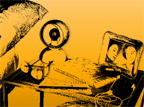
Art as Disease
Random and Artificial are proud to present The Possible Ties Between Illness and Success by Carlo Zanni, a two minute movie transformed by an Internet data flux and re-edited server-side when web statistics (Google Analytics) are available: the public can watch a new movie every day. Opening: August 3rd 2006 at La Rada Centro Per l’Arte, Locarno as part of WIRELESS a show in partnership with 59° LOCARNO INTERNATIONAL FILM FESTIVAL.
The core idea of the work is the relationship between manic-depressive illness forms and success at large, a theme it symbolically tracks through the filming of a ill man lying in a bed and the presence of his partner (actress Stefania Orsola Garello). The man’s body (actor Ignazio Oliva) progressively fills with stains: quantity and position depend on the number of users (and country of origin) visiting the website. The more users, the more stains, thus causing the "illness" to spread all over the body. The public grants success while appropriating the body of the artist.
The title of this work has been derived from a review of a book called Touched with Fire: Manic-Depressive Illness and the Artistic Temperament by psychiatrist Kay Redfield Jamison. This is basically a work dedicated to all those people living beside someone suffering or experiencing bipolar disorders.
Music for the film is by acclaimed composer Gabriel Yared (The English Patient, Cold Mountain); words of the voice playing over the film are taken from the last page of American Purgatorio, a novel by Brooklyn based American writer John Haskell, who also plays the text in the English version.
"Art as disease. And success as a contagious and self-destructing process. In a challenging mix between cinema and live Internet data. The Possible Ties Between Illness and Success is a visual statement about the ancient theme of malaise as a typical artistic condition, built with tools and metaphors of our technological era." (Valentina Tanni)
Posted by jo at 02:56 PM | Comments (0)
Cultural Control and Policy on Dance in Asia-Pacific Region
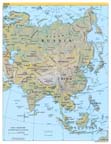
Call for Participation and Partners
[posted by Yukihiko YOSHIDA] Archive/Database: Publication and Material list for Cultural Control and Policy on Dance in Asia-Pacific Region :: Call for Participation and Partners :: Yaping Chen, PhD (Taiwan) :: Yukihiko YOSHIDA (Japan) :: The study in cultural control and policy would be an important field in dance research now, especially when we analyze the development of dance in Asia Pacific Region. Hence, a multi-lingual online archive serving as an exchange platform for research materials will greatly enhance cross-cultural research and understanding of this specific subject.
Now the first ever project in this regard is underway. As the first step, Yukihiko Yoshida and Dr. Yaping Chen are making publication and material lists for cultural policy related to dance under Japanese Colonialism before WW2. Even in Japan, this is still a hidden subject in both Japanese and Asian dance history researches. Yukihiko is currently compiling such a list within Japan. Related materials in difference languages are believed to exist in countries ranging from Japan, China, Taiwan and Korea to South-east Asian countries such as Malaysia. All the contributed lists will be credited with the contributors’ names and shared in the online archive.
Cultural policy under Japanese colonialism is just the beginning of the project, and compiling lists are but the first step. We hope to include publication and material lists from the more recent past in the archive as well. The ultimate goal of the project is to facilitate and promote researches in the relationship between cultural policy and dance throughout Asia-Pacific Region. In the future, cross-national research projects may be conducted through the international connections made possible by this online archive.
We look forward to welcoming new members and partners.
contact address: Yukihiko YOSHIDA, yukihiko9[at]s6.dion.ne.jp
Posted by jo at 02:45 PM | Comments (0)
Transubstantiate: Disruptive Innovation

Call for Submissions
Transubstantiate: a peer-reviewed, online journal for performance technologies praxis :: Call for submissions :: Deadline: November 1, 2006 :: Transubstantiate welcomes submissions for its inaugural issue on the theme of Disruptive Innovation. We seek examples of new thinking and practice that overturn and / or reassess existing performance technology praxis. Submissions may be presented as papers, reviews, audio, visuals (stills / video) and code. Authors may use multiple formats in a single submission.
Topics of interest include, but are not limited to: * Networked performance * Disruptive innovations & discourse * Pedagogy, ontologies and epistemologies * Choreography for iPod. Choreographies for iPod must be specifically devised works and may take the form of: * Video / stills * Audio description / instructions * Text description / instructions * Soundscore with text description / instructions.
Transubstantiate encourages submissions that take an alternative stance on established modes of mediated performance. Submissions should be equivalent to 3000 - 8000 words in .doc, mp3, .jpg or .mp4 (video) format.
The deadline for submissions is November 1, 2006. For more information or to submit please contact the editorial & curatorial board via curators [at] transubstantiate [dot] org.
The liminal is limited; transubstantiate.
Posted by jo at 02:33 PM | Comments (0)
MOBILE/ IMMOBILIZED: Art, biotechnologies & (Dis)abilities
Call for Papers
MOBILE / IMMOBILIZED: Art, biotechnologies & (Dis)abilities :: Call for Papers for the colloquium :: Montréal, October 2007 :: Please submit, to the Centre Interuniversitaire en arts médiatiques :: gram[at]uqam.ca :: a short biography (15 lines) :: an abstract of 250 words maximum :: before September 1, 2006.
A human being would lack nothing, if one were to admit that there are a thousand ways to live. - Canguilhem :: Following the activities that took place within the framework of two colloquia, "Interfaces et Sensoralité" (2003) and "Arts & Biotechnologies" (2004), and based on the work with the handicapped conducted, over several years, by the group at Cyprès in Marseille, we believe it is opportune to provide a site for insightful reflections on questions relating to (dis)abilities. At the intersection of several contemporary art projects, bioscientific research and technological innovations, the notion of deficiency seems to be one of the most fertile and troubling forces. It certainly has a pronounced affect on the experimental art scene, where it generates a significant array of creative, phantasmagorical and symbolic artworks.
Redesigning the Human
Indeed, it seems important, at the present time, to evaluate how technologies and biotechnologies affect the condition of viability, of autonomy and disability of people, and to observe any signs of evolution that signal an increase in cognitive, mental, imaginary and symbolic capabilities. All disciplines involved in the redesigning of the human being are included within the framework of this colloquium. On the one hand, these disciplines occupy the central stage, determining and illuminating the orientation and objectives of the project Mobile / Immobilized, and on the other hand, they serve as a gauge, allowing one to evaluate the techno-anthropological and political impact of practices exerted by humans on humans.
The Augmented Body
Increasingly, technological developments give the impression that human beings are inadequately equipped. This section of the colloquium concentrates on artistic works whose orientation and experimental factors open up conceptual possibilities as well as practical applications for people with deficiencies or constraints (Virtual reality, biofeedback, motion captures, interactivity, synthetic voices, sound, technological extensions, implants, etc.) Artworks will also be presented by people with disabilities who have, because of their deficiencies and their differences, strengthened their sensorial capabilities, and so produce unique poetic and phantasmagorical worlds with technological tools (images, digital photographs, video…). Since such works are adapted to particular disabilities, in certain cases they may result in technical or technological solutions that offer potential uses for the broader
public.
Art as a Life Laboratory
The question here is the study of artistic approaches that propose an important slippage towards a centre of gravity different from the site of current art practices. It is a matter of considering new artworks and artistic processes as cognitive tools, charged at one and the same time with an emotion and with indissociable cognition, artworks that permit one to conceive of strategies for inventive learning and adaptation in order to try to find new symbolic and sensory forms. These approaches permit one to redefine artistic activity in terms of the laboratory of life by actively participating in the development of tools that work for, and in concert with, handicapped persons. This can be done by considering specific imaginaries, unique forms of creations and creativity, and modes of global communication.
Artists, theorists, (bio)scientists, and (bio)engineers) working in related fields are invited to present their artworks, ideas and research, as well as certain developments and applications in this domain.
Posted by jo at 01:32 PM | Comments (0)
Emergences 2006 Festival

New Artistic Forms and New Media
Emergences 2006 Festival: New Artistic Forms and New Media :: September 29th - October 1, 2006 :: Maison de la Villette :: Performances | Concerts | Installations | Shows | Conferences | Works in progress :: International festival dedicted to electronic cultures and emerging artistic forms, Emergence brings together, ever year in Paris, French and international actors in digital creation (cultural centers, art groups, research labs, multimedia production firms...) all gathered around a prolific and international artistic program at the crossroad between performing & visual arts, multimedia, design, architecture and electronic music.
Every couple of years, Emergences takes part in the biennal Villette Numérique event. This year, video game is the spearhead of Villette numerique which is to happen at the Cité des sciences et de l’industrie (all to know about video games: history of, demonstrations, displays, meeting and debates), at la Géode (movies and musics with 180°) and at la Maison de la Villette (Emergences festival).
This fourth edition of the festival asks the question of artistic diversion of everyday objects by invinting artists to express their position vis-à-vis the market place of the information society (video game consoles, cell phoning, GPS, web services, videoconferencing...) and especialy the video game culture.
The program is revolves around evening events at la Maison de la Villette: shows, music lives, performances, animated films inspired by video games and twisting their codes and esthetics; around an artistic process dedicated to the "Game art" which will spread from la Maison de la Villette to the Cité des sciences et de l'industrie thus connecting the two spaces. At daytime, conferences and works in progress are going to supplement this artistic programming.
Lastly, somewhere between Paris and Strasbourg, Emergences is once again getting off its territorial borders to develop arty ties with its partner "Les Nuits Electroniques de l'Ososphère", a festival in Strasbourg which takes place over the same period: simultaneously program network creations and performances, numerical experiments, live retransmissions and ephemeral radio in the two events.
All in all, they are more than 30 artists who are to participate to this new edition of Emergences: Marcel.lì Antùnez Roca, Marnix de Nijs, Yan Duyvendak, //////////fur///, Habbo Hotel, MEC (Motards En Colère), the art group Exyzt,...
>> more
Posted by jo at 09:29 AM | Comments (0)
Arte Digital Rosario 2006 - Muestra01

Call for entries
Rattlesnake Productora Independiente invites you to Arte Digital Rosario 2006 muestra 01
This event will take place both on and offline. The online part will be held at:
http://www.rattlesnakeproductora.com. This will be online on 25 july and it will remain online.
The offline part will be shown at The Center of Contemporary Expressions in Rosario / Argentina. The categories available for submitting projects are the following:
1 . Digital Video
:On /off line
Category: Fiction, Experimental, Animation, 2d ,3d ,Comic.,Vj Reels
2 dvd , PAL the maximum of 30 minutes.
2- Digital Photo
On /Off line.
A-Digital Camera
2 cds, one copy paper 20x30cm for each work ..
b- Cell Phones
2 cds ,one copy paper best resolution
3. Modified Games
Online., Off line
2 cd or 2 dvd
4. Net Art
Online., Off line
link from your site without limits of weight
5. CD-ROM:
Online., Off line
Compatible Windows xp /pc compatible .Fla .Swf /Flash 8
2 CD or 2 dvd
6. Art Installation:
Send synopsis of the project, photos, photos of
scale models, videos and measures of ocupacion of the space.
for its preselection.
7 Performances:
Send synopsis of the project, photos, photos of
scale models, videos and measures of ocupacion of the space,
for its preselection.
8. E-Music:
Music demos from DJ/Musicians, Bands,etc. And everything related with e-music.No covers bands or works will be accepted.
Preselection.
A preliminary jury established by the organisers will select - according to artistic merit, expression, originality and creativity .
Submission: starts 25 july 2006
Deadline: for entries is 25 october 2006.
Works will only be accepted when the postage date does not exceed deadline. The organisation of the Festival cannot be held responsible for eventual damage done to works in transit.
These works will be advertised in the Press and may be included in all and any promotional pieces produced and broadcast by the Festival.
Copy of the selected works will be held as property of Rattlesnakes , as part of the historical collection of Art Digital Rosario muestra 1. These works can be accessed and viewed by the public, free of charge, as well as exhibited in other festivals, screenings, shows and cultural activities, always mentioning the piece's participation in the Festival.
The complete entry information and the submission form can be found on
http://netex.nmartproject.net/index.php?blog=8&cat=25
Posted by luis at 09:25 AM | Comments (0)
July 26, 2006
Remote: a multimedia performance by Kraft and Purver

Connection, Control and Safe Distance
Remote: a multimedia performance by Kraft and Purver :: When: Aug. 3-12, 2006 (Thurs, Fri, Sat @ 8pm) :: Where: CounterPULSE, 1310 Mission St. (at 9th), San Francisco :: Reservations: (415) 435-7552 :: How Much: $12-15 weekend of 3rd, $15-20 weekend of 10th.
"The further you are, the closer I feel to you… please, stay away" – Remote :: In a time where traditional intelligence networks seem to have failed, and where "faith-based" decisions challenge scientific "objectivity", this new multimedia theatre project by award winners Kraft + Purver weaves live video manipulation with theater to blur the lines between reality and perception.
Both hilarious and revealing, Remote draws from factual research into bizarre experiments in psychic spying performed by the U.S. military and the CIA, and also from the impact of communications technology on the nature of relationships, and takes an unconventional look at our attempts to connect and control while still paradoxically maintaining a safe distance.
Through the re-enactment of military efforts to train psychic spies, and of a real-life long distance relationship conducted through the internet, Remote explores how distance can afford us both the grace of perspective and the capacity for violence. The performers interact live with onstage video effects that transform their physical gestures into 3D graphical landscapes, as they attempt to find their way through the maze of their own thoughts in order to find their targets.
Conceived and designed by Kraft + Purver, Remote is performed by Sara Kraft and Ed Purver, with Ernie Lafky and Rowena Richie. Sound and Music by Sheldon Smith.
"Transporting, shrewdly evocative, and often very funny, their creative process suggests two precocious, deeply mischievous children with advanced degrees and the keys to the laboratory" – San Francisco Bay Guardian
Posted by jo at 06:55 PM | Comments (0)
Ars Virtua
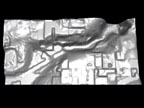
The Second Life Landscape Initiative
"A landscape comprises the visible features of an area of land, including physical elements such as landforms, living elements of flora and fauna, abstract elements such as lighting and weather conditions, and human elements..." -- wikipedia
The landscape is well understood in real-space as a driving force of the economy, an inspiration and a refuge. Ars Virtua is proud to present The Second Life Landscape Initiative. In this exhibit we are testing the boundaries of translation and connection. What happens to our relationship with the environment when we enter the synthetic world?
We examine four plots of land through data, analysis, visual imagery and prose. We then ask the viewer to engage the landscape and form their own memories and associations.
This exhibit looks at the land of Second Life through several lenses and tries to find a closer connection, this is not merely the distant gaze of the scientist but the the gaze of a lover or of a poet. We examine the data, forms, texture, images and stories that come from the land. Ars Virtua invites its viewers to come to the show and then to walk the surrounding lands of Butler and Dowden in search of their own narratives.
We will be highlighting the work of Lucid Vindaloo, LestatDe Lioncourt, Fiend Ludwig, Zero Philo. The SLLI (Second Life Landscape Initiative) opens Friday July 28th at 7pm SLT in Gallery 2 of Ars Virtua along the Butler/Dowden sims.
Located at the border of Butler and Dowden in Second Life's virtual environment, Ars Virtua's 3000 square meter two story building is divided into main and secondary galleries and a residency space. In order to visit Ars Virtua you will need to create a free account at Second Life (http://secondlife.com/join) and need to be running the current client. Once you have this properly installed you should be able to follow this link directly to Ars Virtua
secondlife://butler/228/15
Ars Virtua: Gallery 2, Butler (228, 15, 52)
http://slurl.com/secondlife/Butler/228/15/32/
Posted by jo at 06:01 PM | Comments (0)
Anne Galloway
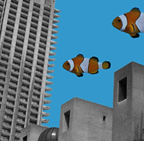
Technosocial Screens
I'll be giving a keynote address at next month's BNMI Interactive Screen - Margins: Media: Migrations workshop & summit.
Technosocial Screens: Mobilities, Communities, Citizenships: screen, v. to show, or hide from view; to sift or separate; to shelter or protect
New interactive technologies promise to reconfigure relations between producers and consumers, public and private, physical and digital, local and global - and in these shifting scenarios the screen takes on a multitude of roles. Not only are screens changing size and resolution, some are becoming softer and more flexible, and others are disappearing entirely. Some screens offer a bird's-eye view of the world that we can hold in our hands, and others tell us where we are - or could be - at any given moment. Whatever the type of screen, we can be sure of one thing: people, places, objects and ideas are being screened at the same time.
Together we will explore some of the critical ways in which new media technologies shape, and are shaped by, our changing experiences and understandings of community and citizenship. What kind of shelter and hope can we expect from a world of everywhere and anywhere media? From what, and whom, are we protecting ourselves? How are these technological practices sorting our everyday social, cultural and creative relationships? What, and whom, gets hidden - or cannot hide? How can new media technologies explore different ways of belonging and being together? How can they encourage diverse and lively participation and representation around shared matters of concern?" [...] [blogged by Anne on Purse Lips Square Jaw]
Posted by jo at 05:42 PM | Comments (0)
Digital Performance Institute
![]()
Open Call: Artist Residency Program
Gertrude Stein Repertory Theatre (GSRT)’s mission supports technological innovation in the performing arts. Following that focus, GSRT’s Digital Performance Institute (DPI) encourages arts experimentation & the thoughtful use of emerging technology & media tools. GSRT is performance oriented, but DPI exists as a think-tank for experimentation beyond discipline boundaries. To this end, we are pleased to announce an open call for applications to the DPI Artist Residency Program, which will provide artists with free access to rehearsal & meeting space, equipment, and media creation facilities. The residency also offers opportunities for pubic showings and consultation from other media artists.
Through our artist residency program, DPI aims to provide a context for working in experimental ways with new media. The residency program is not focused on the creation of full productions, but on experimentation. By providing artists with more time to develop the media component of their work, we hope to encourage a greater dialogue about the intersection of technology and performance. A key component of the residency program is that artists share their discoveries with their peers through public Open Labs and on DigitalPerformance.org.
Previously participating artists include Kate Brehm, Dustin O’Neill, Alyse Rothman, James Scruggs, Sarah Smirnoff, Marek Walzak, Karin Wiliams, and Michael Wilson. Current residents include Meghan Trainor, who works with a Learning Worlds programmer to build 16 HORESPOWER, a RFID & sculpture performance; and Margot Lovejoy, who is developing Confess-It, a documentary web site & sound environment. Continue reading guidelines. See application instructions.
Hal Eagar, Associate Artistic Director of the Gertrude Stein Repertory Theatre, leads DPI's artist residency program. For questions regarding the program or application, please contact hal[at]gertstein.org or (646) 442-4435.
Posted by jo at 05:30 PM | Comments (0)
UPGRADE! BOSTON:
![]()
New Media and the Poetics of Communication
UPGRADE! BOSTON: New Media and the Poetics of Communication :: WHEN: August 1, 7:30-9:30 p.m. :: WHERE: Art Interactive, 130 Bishop Allen Drive, at the corner of Prospect Street, Cambridge. Free parking in the lot on the corner or take the T to Central Square and walk 1 block.
Adam Brown (Oklahoma, US), Martha Carrer Cruz Gabriel (Brazil) and Michael Takeo Magruder (UK) -- all exhibiting at SIGGRAPH2006, Boston (July 30 to August 3) -- will present their work and participate in an informal discussion; Bonnie Mitchell, SIGGRAPH2006 Art Gallery: Intersections Chair will moderate.
PARTICIPANT BIOGRAPHIES
Adam Brown is a digital artist and inventor. His creative activity is informed by an intermedia tradition that supports collaboration among various disciplines resulting in a practice that blends digital media with physical materials. Brown has exhibited nationally and internationally and is the recent recipient of a Turbulence commission. He curates Upgrade! Oklahoma which is hosted by Untitled ArtSpace and The University of Oklahoma's School of Art. Brown is also a member of the New York Sculptors Guild.
Martha Carrer Cruz Gabriel is an engineer, postgraduate in Marketing, and postgraduate in Graphics Design. Master's Degree in progress on Art & Technology at University of São Paulo. Web/MM artist, professor at the Business School and Digital Design Program of the Universidade Anhembi Morumbi, director of technology at NMD - New Media Developers. Winner of 11 Internet Best Awards from 1998 to 2005. International awarded speaker. Gabriel has had two Turbulence Spotlights.
Michael Takeo Magruder is an American artist based in the UK who works within the fields of new and interactive media. He received his formal education at the University of Virginia, USA, graduating with distinction in Biological Sciences. His artistic production has been exhibited worldwide and encompasses an eclectic mix of forms, ranging from futuristic stained-glass windows, digital light screens and modular light-sculptures to architectural manipulations, ephemeral video projections and interactive network installations. His current explorations and research embrace 3D stereoscopic projection, immersive multi-sensory environments and interactive non-linear narratives for network/gallery settings. His work in these fields is presently supported by Turbulence.org, King's Visualisation Lab: King's College London and Arts Council England. Magruder is the recipient of two Turbulence commissions.
Bonnie Mitchell is an Associate Professor in Digital Arts at Bowling Green State University, Ohio, USA where she teaches time-based media with a focus on artistic expression and technical problem solving. With degrees in Art Education, Visual Design/Computer Art and Computer Science she focuses on curriculum that is artistic, technical and cross-disciplinary in nature. She typically teaches interactive media, experimental animation, particle systems and dynamics, and collaborative multimedia production classes. Mitchell’s artworks explore spatial and experiential relationships to our physical, social, cultural and psychological environment through interaction. She typically develops large-scale immersive installations that integrate electronics, animation and audio to create responsive art environments. Her electronic installation art and international collaborative web art projects have been exhibited at ISEA, Prix Ars Electronica, and Digital Salon among others.
Upgrade! Boston is curated by Jo-Anne Green for Turbulence.org in partnership with Art Interactive. It is one of 20 nodes currently active in Upgrade! International, an emerging network of autonomous nodes united by art, technology, and a commitment to bridging cultural divides. If you would like to present your work or get involved, please email jo[at]turbulence.org.
Posted by jo at 04:44 PM | Comments (0)
Game/Play presents

Abiogenesis
The Game/Play team are pleased to present: An online performance by Tale of Tales - Auriea Harvey and Michael Samyn, in The Endless Forest :: Thursday July 27th 7.00pm – 8.00 pm (BST) :: Free, all are welcome :: To play: Download the Endless Forest 'social screensaver'.
Come and meet us online within the live, real-time world of 'The Endless Forest'. "The Endless Forest by Tale of Tales is a game about beauty, wonder, calm and peace. There are no stealth missions, no guns to swap, no armour or enemies. Taking on the role of a somewhat dreamy deer who wanders through an endless forest imbued with magical powers that seem as unpredictable as mesmerising, players of The Endless Forest are invited to hang out and roam amidst beautiful trees, old mysterious ruins, an idyllic pond and happy flower beds. Without a goal of any sorts, they soon find that there’s more to the forest than just mere eye candy." Maaike Lauwaert & Martijn Hendriks. Read full text.
"In keeping with Wirefire, an earlier project involving a series of intimate live, online performances on the theme of love, the artists intermittently appear as the ‘gods’ of the Endless Forest. Using a system they call Abiogenesis the virtual woodlands become a mutable stage for the artists’ performances." Ruth Catlow & Marc Garrett. Read full text.
The touring Game/Play exhibition is currently showing at Q Arts, Derby and HTTP, London.
Posted by jo at 01:53 PM | Comments (0)
Mouthpiece + Dis-Armor
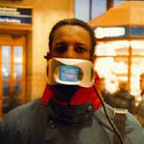
Prosthetic Communication Equipment
The Mouthpiece has been designed to help strangers who find it difficult to express their feelings or opinions face to face. A small LCD monitor and loudspeakers are covering the mouth of the wearer like a gag. The equipment replaces the real act of speech with pre-recorded, edited and electronically perfected statements, questions, answers, stories, etc.
The Mouthpiece "replaces" the actual act of speech with the moving image of the immigrant's lips and the sound of his/her voice. The small size of the screen forces viewers to come closer in order to see the image of speaking lips and to hear the voice clearly, reducing the distance between the immigrant and the other.
The Mouthpiece points to the absurdity of depriving speech rights in a democratic society. It responds to the actual political process and experience of such deprivation, while at the same time it helps to translate this disadvantage into a new advantage. This stranger becomes an expert and a virtuoso in the technology and the artistry of speech, equipped to speak better than others who have yet to overcome speechlessness in their encounter with strangers.
Designed in 1994 by Krzysztof Wodiczko, author of the Homeless Vehicles. The artist also developed Dis-Armor (1999-present), another psychocultural prosthetic equipment designed to meet the communicative need of the alienated, traumatized, and silenced residents of today's cities.
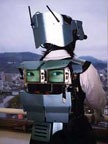
Dis-Armor allows it wearers to speak through their backs. LCD screens on the back display live images of the user's eyes transmitted from cameras installed in the helmet. A speaker amplifies his/her voice. Attached to the helmet is a rearview mirror, alternatively, a rearview video camera, monitor, microphone, and headphone enable the user to see the face and hear the words of who is standing behind. Wireless video equipment further allows two users to work in tandem, showing each other the other's eyes and broadcasting to each the other's voice.
Dis-Armor focus on the psychological difficulties of Japanese high school students and "school refusers," who live in silence and lack facial expression. It uses the ancient traditions of arms making to conceive of a playful alternative to intimidating face-to-face communication. [blogged by Régine on we-make-money-not-art]
Posted by jo at 01:32 PM | Comments (0)
makearevolution.net

How is it possible to make a political change?
Concerned to cause a shift to a more collective mode of cultural production, fully embracing Foucault´s critique of the author's name in favour of collective authorship, Makearevolution* is a project that invites everyone to post revolutionary statements, and to share their major concerns about culture, global/local geo-politics, power, labor, environment, post-social issues, etc. The objective is to explore the relationships between contemporary art and current cultural and political trends. It will focus on revolution as a pervasive cultural phenomenon and explore connections between the art system and revolutionary ideology.
Makearevolution* will deal with themes related on different levels, be they social, political or aesthetic, and in this way address current democratic discussions. Key questions are how forms of revolution have historically been propagating or reacting against discourses of modernity, and how a high level of stylistic and "aesthetic" consciousness is central to revolutionary movements' quest for mass appeal.
Makearevolution* is an ongoing and mobile project that can be presented in different nonprofit art and non-art spaces. This structure is ready to put in practice revolutionary ideas and ideals near you. invitations from all over the world are accepted in order to build and develop revolutions near you. For more info, please contact makearevolution.net at info[at]makearevolution.net.
Posted by luis at 12:52 PM | Comments (0)
UPLOAD 09
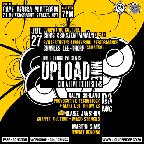
Creative Collisions
UPLOAD 09: Creative Collisions :: Dates: Thursday 27 July and Thursday 3 August 2006 :: Time: 6.30 for 7-10pm :: Venue: CAPE Africa Platform, 71 Buitengracht Street, Cape Town :: Cost: Free :: Liquid Fridge presents two workshops on mash-ups of art forms with each other and technology, with presenters Chris Csikszentmihályi from MIT (USA), Ralph Borland, Charles Lee-Thorp, Blaise Janichon and Martin Sims.
Presentations cover counter-cultural technologies, socially activating projects at the intersection of art and design, next-generation VJing, graffiti and street art culture, and re-purposing electronics for audiovisual performance. The workshops also feature exercises on making graffiti stencils and LED throwies (electronic graffiti).
Posted by jo at 11:44 AM | Comments (0)
Unravel: the SIGGRAPH2006 Fashion Show
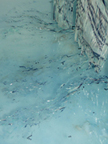
Wonderland - The Disappearing Dress
This project aims through the innovative marriage of art, science, fashion, technology and education to engage public consciousness through more positive currency, through humor, imagination and wonder, both on behalf of the next generation of consumers as well as existing ones. The Disappearing Dress is part of this wider project.
The garment is constructed of a water soluble polymer. When dissolved the fabric turns into a tiny amount of liquid gel which can be reconstituted into a solid once more or used to grow plants. The dress is a dramatic illustration of how the material behaves.
The Disappearing Dress will be at Unravel: the SIGGRAPH2006 Fashion Show on July 31, 2006. In future exhibitions, in London, Sheffield and Belfast in 2007, there will be a series of dresses which will dissolve over the course of 3 weeks and these will be the introduction to the other half of the project - ‘Ideas that can change the world’, practical and inspiring ideas for environmentally sound products and recycling methods.
The Disappearing Dress project is by Prof. Helen Storey of The Helen Storey Foundation; Prof. Tony Ryan of The Polymer Centre at Sheffield University; Patricia Belford and Aoife Ludlow, Interface at University of Ulster. It is funded by the Engineering and Physical Sciences Research Council. More information about Wonderland and Ideas that can change the world is available at:
http://www.helenstoreyfoundation.org
Posted by jo at 10:32 AM | Comments (0)
Unravel: the SIGGRAPH2006 Fashion Show

Garments as Secondary Skins
Unravel: the SIGGRAPH2006 Fashion Show presents a runway show of innovative and experimental works in computational and conceptual couture, fashion with a social agenda, science-inspired form, and new technologies of material fabrication. Unravel brings together the work of designers and artists from the US, Canada, Europe, and Asia who are seeking to redefine the notion of ‘wearable.’
In the increasingly mobile nature of contemporary life, it has become important to contemplate how the devices we carry and the garments we wear converge into a ‘secondary skin’ which function as an extension of ourselves, in both ability and perception. By using fashion, a medium which has always been associated with self-expression and personal identity, these designers seek to demonstrate how the use (or misuse) of technology and its modes of production have the power to stimulate, delight, and inspire in ways as yet untapped in the fashion world.
Gone are the stereotypical bulky cyborg devices; what emerged are garments of beauty, subtlety and elegance in form. Some bring to light important social issues — redefining our notions of personal space, networked environments, and issues of privacy and protection. Others relish in pure delight, reminding us how technology also has the power to enhance our personal relationships and celebrate fantasy and play as part of the human condition.
A few projects:
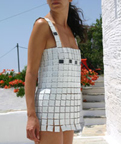
Day For Night (Modular Extensible Reconfigurable) by Studio 5050 - Despina Papadopoulos & Jesse Lackey: Day-for-Night: a dress comprised of 436 white circuit boards that are linked together with metal rings. Each tile is addressable from a central control unit at the back of the dress. Solar cells are embedded on some of the tiles and charge the dress during the day. The dress is completely modular both in hardware, as new tile functionalities can be added and in terms of software. The control unit has an RF receiver module which can receive new programs from a programming USB board with an RF transmitter.
IPV – Clothing System by Adam Whiton (Industrial Designer and Artist) and Yolita Nugent (Apparel Designer): a wearable system designed to intervene in domestic violence situations.
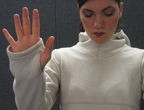
The smart clothing utilizes pressure sensitive fabric to measure impacts to the wearer’s body. The physical abuse data is transmitted to a remote server where it can be archived or distributed to a trusted community or proper authorities. The wearer can chat with their IPV clothing via an artificial intelligence agent that offers them feedback and suggestions based on the received data. This project explores the wearable as a self reflective safe space to assist the abused wearer in reconnecting with social networks. [Also see the No-Contact Jacket]
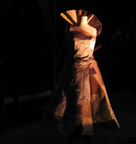
Peau d’Âne by Valérie Lamontagne (Artist and Designer), Lynn Van Gastel (Fashion Design), and Patrice Coulombe (Technical Design): In the Charles Perrault fairy tale “Peau d’Âne” a young princess, whose stepfather’s riches are dependant on his gold excreting donkey, orders the impossible from her doting father in order to avoid having to marry him: three dresses made of immaterial materials: the sun, moon and sky. The aim of the project “Peau d’Âne” is to incarnate these “impossible” dresses in a material form. A weather antenna culls live weather data, which transforms the dresses, reflecting the changing barometric characteristics of sky, moon and sun in real-time. The “Sun” dress is based on changes in the sun. The dress will be constructed with a checkerboard of LEDs (light emitting diodes) set in motion based on UV, solar radiation and sun intensity readings.
Posted by jo at 10:18 AM | Comments (0)
Upcoming workshop: @ Mediamatic Amsterdam
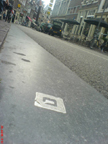
RFID and The Internet of Things
After a succesfull CrashCourse in May, Mediamatic now presents a second workshop on RFID and The Internet of Things :: 11, 12, 13 September 2006 :: Confirmed lecturers and trainers: Julian Bleecker (US), Timo Arnall (Norway) and Arie Altena (NL).
RFID allows for the unique identification of objects, and any kind of online data can be linked to these unique ID's. If RFID becomes an open web-based platform, and users can tag, share, and contribute content to the digital existence of their own places and objects, we can truly speak of an Internet of Things. This opens perpectives for new sustainability scenario's, for new relations between people and the stuff they have, and for other locative applications.
The participants of this workshop will develop critical, utopian or nightmarish concepts for an Internet of Things in a hands-on way. Ideas can range from scripts for small new rituals to outlines of societal changes of epic scale. Prototypes can be tested with the workshop tools The Symbolic Table or the Nokia3220 phone with RFID reader.
The workshop has room for 16 designers, artists, thinkers and makers. Participation fee is €350 per person, ex BTW. Lunches, technical equipment and assistance are included. If you want to participate in this workshop, please register at our online registration form.
Posted by jo at 10:01 AM | Comments (0)
Flüux:/terminal

A Bipolar Performance
Flüux:/terminal is a bipolar performance that skoltz_kolgen have named diptyque rétinal . As in all Of their work, here their research has established a point of contact between sound and image. But Flüux:/terminal pushes the dialogue between these two elements one step further: their performance Creates a dramatic tra jectory, fuelled by the panoramic tensions (left/right) between hearing and seeing.
Flüux:/terminal projects images on two screens, in a parallel visual body of luminous particles_ photographed or filmed images and wire frame displays. As stereophonic visual representations, the two screens are the alter egos Of the audio, which is also divided in two. The sound sources (left/right) are desynchronized and propelled into separate channels: the left-hand channel excites the left-hand image; the right-hand channel excites the right-hand Image. The image is distorted, bearing the marks that the sound imprints upon it, and becomes the fossil of the sound.
A bipolar experience is therefore built by catalyzing the lines of tension between two Independent but related audio and visual worlds. Their dissociation in one instance and their synchrony or symmetry in another establish space–times that fairly float in weightlessness. These suspended moments are succeeded by fresh charges of energy that are massive and intense. A new generation of meaning escapes: attraction and repulsion, interdependence at times, followed by struggle and conflict at others.
Flüux:/terminal is a living performance that evolves each time it is presented. In the same evolutionary S p i r i t , The flüux:/terminal album transposes the performance in another environment. Skoltz_kolgen give the audio CD a life Of its own while reprising textures and sound microfragments from the performance and reconfiguring them, stripped of their visual aids. The result is more musical and minimalist, venturing beyond the raw, polarized qualities of the performance.
Flüux:/terminal will be performed at RECOMBINANT MEDIA LABS, San Francisco on Wednesday August 16th & Thursday August 17th at 8:30 pm. Cost: $15.
Posted by jo at 09:56 AM | Comments (0)
Dark Source
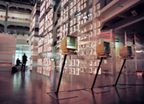
Exposing Democracy Owners
One of the most senseless use of technology is electronic voting. With no advantages except from the speed (real time) county of votes, this 'innovation' is simply an enormous swindle. In fact the votes are stored as files, so infinitely more falsifiable than the one written on the traditional paper, and the worst is that the whole process is managed by proprietary software, so with unstable and unintelligible methods. Part of the Weibel-Latour ZKM's Making Things Public exhibition, Dark Source by Ben Rubin makes this paradox even more evident. It consists of a representation of the Diebold AccuVote-TS touch-screen voting terminals, recently adopted in many U.S. states. It's a printout of some of the 49,609 lines of C++ source code (other pages are available through some microfiche terminals), with all the same code blacked out, because of the trade secret the company claimed as a property on its intellectual product.
This is a stunning representation of an absurdity: the act of gifting the employees of a trade secret defending company the right to manage and frame the most important democratic process. Then the question is: there's any election procedure that can be kept secret or privately owned? Not really. But unfortunately this is an ongoing experiment going on in many countries, perhaps a testbed to take over the paper/pencil scheme sometime in the future. Technology is not for everything, and this kind of techno-positivism dreams can generate scaring nightmares. [posted on Neural]
Posted by jo at 09:20 AM | Comments (0)
Piksel06
![]()
CALL for PARTICIPATION
Piksel[1] is an annual event for artists and developers working with free and open source audiovisual software. Part workshop, part festival, it is organised in Bergen, Norway, by the Bergen Centre for Electronic Arts (BEK) [2] and involves participants from more than a dozen countries exchanging ideas, coding, presenting art and software projects, doing workshops, performances and discussions on the aesthetics and politics of free and open source software.
This years event - Piksel06 – continues the exploration of audiovisual code and it's myriad of expressions, but also brings in open hardware as a new focus area. At Piksel06 we will expand the exhibition part and build upon the open hardware theme, which represents a potential for a new paradigm shift of vital importance for independent artistic expression in the digital domain.
Piksel06 is done in collaboration with HKS art centre[3] which will be the main location for this years events. Piksel is organised by BEK and a community of core participants including members of collectives dyne.org, goto10.org, sustainablesource.net, hackitectura.net, riereta.net, drone.ws, gephex.org and others.
Piksel06 - festival -- october 12-15 2006
Piksel06 - exhibition -- october 13-27 2006
Piksel06 - call for participation -- deadline august 1. 2006
open CALL for PARTICIPATION
The previous Piksel events has primarily focused on live art / audiovisual performance and interactive installations, but for Piksel06 we also introduce open hardware and hardware hacking as new themes. For the exhibition and other parts of the program we are interested in submissions in the following categories:
1. Installations
Projects related to the open hardware theme including but not restricted to: circuit bending, reverse engineering, repurposing, modding and DIY electronics preferably programmed by and running on free and open source software.
2. Audiovisual performance
Live art realised by the use of free and open source software. We specially encourage live coding and DIY hardware projects to apply.
3. Software/Hardware
Innovative DIY hardware and audiovisual software tools or software art released under an open licence.
Please send documentation material - preferably as a URL to online documentation with images/video to piksel06[at]bek.no. Deadline - august 1. 2006
Please use the online submit form at: http://www.piksel.no/piksel06/subform.html
Alternatively use this form for submitting
1. Project name.
2. Email adr.
3. Project URL
4. Name of artist(s).
5. Short bio/CV
6. Category
7. Short statement about the work(s)
8. List of software used in the creation/presentation of the work(s)
Or send by snailmail to:
BEK
att: Gisle Froysland
C. Sundtsgt. 55
5004 Bergen
Norway
More info: http://www.piksel.no/piksel06
piksel06 is produced in cooperation with Kunsthoegskolen in Bergen dep The Academy of Fine Arts, Hordaland Kunstsenter. Supported by Bergen Kommune,
Norsk Kulturfond, BergArt and Vestnorsk Filmfond.
links:
[1] http://www.piksel.no
[2] http://www.bek.no
[3] http://www.kunstsenter.no
Posted by jo at 08:35 AM | Comments (0)
July 25, 2006
Motion Still Life 01
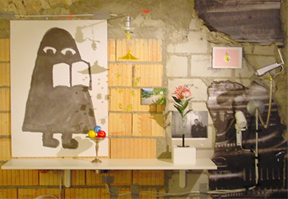
Make your still life, leave your mark...
Will Pappenheimer's Motion Still Life 01 continues at Cabaret Voltaire, Zurich, 'til August 1.
Posted by jo at 02:37 PM | Comments (0)
BioHome: The Chromosome Knitting Project
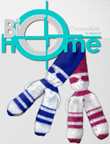
Blurring the Lines Between Home and Laboratory
BioHome: The Chromosome Knitting Project :: A performance/installation featuring live biotechnologies :: Performance by Catherine Fargher, with live sound mix by Terumi Narushima.
BioHome presents a new form of hybrid performance, incorporating live biotechnology in an interactive installation. It also features video, interactive sound using DNA sonification, live DNA knitting and live performance and text. The live 'wet biology' practices, namely knitting DNA and displaying live cell cultures on stage, will be used to explore reproductive futures and bio-technologies.
Opening: August 16, 2006 5.00 p.m. by Natasha Mitchell, ABC Radio National Science Unit. Performance: 5.30 p.m. August 17th, 2006: Performance 5.30 p.m. Installation hours: August 16 - 25, 9-5 p.m. The artist/performer will be in attendance to maintain live cells at select times during the duration the installation. 'we assume all products are hazardous'.
FCA Gallery, Room 112, Building 25, Faculty of Creative Arts, University of Wollongong, Northfields Avenue, North Wollongong. Light refreshments available.
Credits:
:: Writer, performer, devisor - Catherine Fargher
:: Direction and corporeal dramaturgy: Nikki Heywood,
:: Textual dramaturgy, Noelle Janascewska, Nikki Haywood, Merlinda Bobis.
:: Visual dramaturgy: Brogan Bunt, Virginia Hilyard.
:: Knitted elements: Pamela Drysdale,
:: Plasma Screen performers: Terumi Narushima, Catherine Fargher, Denise Cepeda.
:: Interactive sound creation: Terumi Narushima.
Catherine Fargher
writer/editor/doctoral candidate University of Wollongong
PO Box 178
St Pauls NSW 2031
ph/fax: (02) 93145121
mob: 0415 442 209
email:iristorm[at]ozemail.com.au
Posted by jo at 09:45 AM | Comments (0)
Upgrade! Johannesburg: Catherine Henegan
![]()
Dada Goes Digital: Media Art in a Theatrical Space
July 28, 2006 :: Upgrade! Johannesburg and the Wits Digital Soiree present: Catherine Henegan :: Dada Goes digital - Media Art in a Theatrical Space :: Amsterdam-based multi-disciplinary artist, Catherine Henegan, is the director of The Shooting Gallery, the controversial performance / media art work currently showing at The Market Theatre. Aided by a computer and a projection screen, Catherine is also a performer in the work, editing live content from the Internet into the performance by Aryan Kaganof and against the sound design by James Webb. In this way she tracks in real time the way media constructs and reconstructs news and fiction. She will talk about her approach to the design and direction of this challenging multimedia production. More images here.
Posted by jo at 09:26 AM | Comments (0)
Stratoself
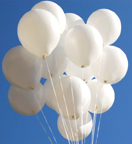
Short-Circuit Between Physical + Virtual Worlds
Stratoself is an interactive sky-art work that was conceived on a short-circuit between physical and virtual worlds. It has been designed by that hybridism: there’s a missing link between internet and helium gas we wanted look for. For such opposite environments we needed a flexible, self-generated, autonomous bridge. Cybercommunities were the best choice.
The idea is to release helium-filled balloons carrying participants' personal email cards inside, in the air. The participant's balloon can be ordered at the project's site and NAUTC.0, (we're group of electronic artists from São Paulo, Brazil) is in charge of assembling the entered data with the biodegradable latex balloons, and releasing them in the air of big cities of Latin America. Anyone who gets or finds a balloon can communicate with the participant via email.
The project aims to find non-conventional means of netting cybercommunities's individuals from all over the world, by temporarily colonizing urban common spaces with private material. To launch that personal electronic piece of data in physical public sites, is a way to discuss how social identity and digital territory is built in the creative boundaries of cybercommunities.
People who want to order their personal balloon and participate in Stratoself's first performance in August 14th, can register at:
http://www.stratoself.com/english.htm
Posted by jo at 09:06 AM | Comments (0)
July 24, 2006
Tap-n-bass
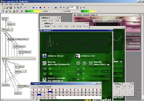
Interactive Dance Technology
Within the field of interactive dance technology, a number of projects have experimented with dancers producing music in real time from their body movements, as opposed to following the music. In MusicViaMotion (2000) for example, dance movements are captured with a video camera and mapped to sound synthesis in real time. In MIT Medialab's Expressive Footwear project (1998) and Katherine Moriwaki's Music Shoes (2000), the dancers wear sport shoes respectively chinese slippers, equipped with a range of sensors. In Alfred Desio's Zapped Taps, sensors are also used, this time on tap shoes. In all these projects, the sensed movements actuate and modulate artificial sounds.
In Tap-n-bass, we took a technological step back and used the actual acoustic sounds produced by the tap shoes instead of sensor data about the dancer's movements. Tap-n-bass is an improvised tap dance performance where the sounds of wired-up tap shoes are picked-up by piezo contact microphones and remixed live, resulting in drum-n-bass-inspired music.
Drum-n-bass is one of the most exhilarating music styles that have emerge during the last few years. Noticing pattern similarities between certain rhythms in drum-n-bass and in tap dancing, we decided to see what would happen if we crossed these two genres. In Tap-n-bass, we aimed at making a tap dance performance that would produce booming bass and fast syncopated rhythms reminiscent of drum-n-bass, while staying true to the genre of tradition of tap dancing and its characteristic sound. The music is produced live by sounds picked-up by contact microphones attached on the shoes. The sounds are filtered and remixed live through a mixer board and custom-made program run on a laptop. The Tap-n-bass performance is improvised and collaborative, in terms of the dialogue established between the laptop remixer and the tap dancers. [via nicolas on pasta and vinegar]
Posted by jo at 06:59 PM | Comments (0)
Satellite Jockey
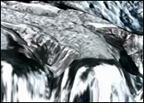
djing Goggle Earth
"If music is about time, Satellite Jockey by Rick Silva is music sparked off space. The perceptive revolution enabled by Goggle Earth is the one of being able to visually navigate most part of the world (including your own neighborhood) through satellite photos. This overwhelming new perspective (a sort of 'God' omnipresent view) is rewriting in the users of this software the spatial coordinates, and the awareness of being in one place, that becomes the center of the universe of choice. Satellite Jockey is a performance that uses Goggle Earth navigating the world's surface through the Google's generated stream of data using it as a source material for audio visual performances. The represented territory, in the software various forms, is then the (infinite) stage on which the performance take place, zooming, flying over, turning around pixel corners or drowning into abstract minutiae. The music follows the visuals, strengthen the vague mood of being ubiquitous and lonely. The author is performing regularly and a preview of one of his latest remixes debuted at the last Futuresonic." [posted on Neural]
Posted by jo at 05:31 PM | Comments (0)
July 23, 2006
Theory of Participatory Art
![]()
participation as activism
Suzana Milevska’s essay Participatory Art: A Paradigm Shift from Objects to Subjects in the 2/06 issue of the journal springerin is a dense, theoretical discourse that raises questions regarding the intersubjectivity of the collective and challenges to the idealization and realization of "community" in participatory art.
springerin is a quarterly magazine dedicated to the theory and critique of contemporary art and culture addressing a public that perceives cultural phenomena as socially and politically determined. A special section of every issue (Netzteil) examines the potentials of new technologies and media.
Posted by michelle at 02:46 PM | Comments (0)
July 21, 2006
Open-Ended Utopia:
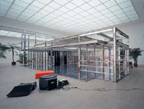
The art of Rirkrit Tiravanija
"[...] (Rirkrit Tiravanija) transforms galleries into kitchens that serve up free pad Thai. He turns museums into low-power radio stations, a replica of his New York apartment, a functioning mechanic's shop, and a studio where "street TV" is broadcast to the neighborhood. He builds chrome-plated kitchen consoles, theatrical stages out of plywood and 2x4s, and replica modernist homes from glass and steel, then invites people in to do... whatever: rehearse with their band, sleep, eat, listen to a DJ, debate topics of the day, read. And he plays informal host at an off-the-grid rice farm in Thailand that's art only insofar as it fits his definition of the genre as "a space for possibilities." [...]
You could say his art is all about building "chaotic structures." Then again, it's about lots of things; his work is so open-ended and departs so radically from the art market's orientation toward precious objects, that it’s earned many labels, many – like utopian or chaotic – that only tell part of the story. But one that's stuck is French theorist-critic Nicholas Bourriaud's "relational aesthetics," the idea of judging the social relationships sparked by an artwork instead of merely considering the object [...]" From Open-Ended Utopia: The art of Rirkrit Tiravanija by Paul Schmelzer, Eyeteeth: Journal of Incisive Ideas.
Posted by jo at 06:36 PM | Comments (0)
BUMP…
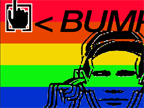
Reinstates the Virtual World with an Offline Voice
Artist Jaygo Bloom has been commissioned by folly, a media arts organisation based in Lancaster, to develop the sound work BUMP… for this year’s Futuresonic festival, in partnership with Manchester based digital signage organisation Pixel Inspiration. Futuresonic is the UK’s leading electronic and media arts festival, and takes place in Manchester in July 2006. According to Jaygo Bloom, the commissioned artist, "As computer technology becomes more sophisticated, the technology itself will fade into the background of human activities, becoming far less intrusive than is the case today."
Jaygo Bloom suspects the invisible, therefore he seeks to reverse the need for this technological transparency. BUMP… reinstates the virtual world with an offline voice. BUMP… is an online project that translates an online keystroke into an actual real time and physical event. BUMP… will reinstate the presence of this technological intervention over its environment via the quick shot, rapidfire, 8bit sounds emanating out of its location based folly sound modules located throughout participating venues of Futuresonic 2006. BUMP… presents an interesting view of networked interaction and social performance.
Jaygo Bloom concludes, "By attaching a physical connection to things we perceive as virtual, we can begin to make the intangible tangible."
Jaygo Bloom is a UK based multimedia artist whose practice includes audio visual installation, game hacking, film making and physical computing. Over the past year he has been developing a wide variety of new online and offline projects ranging from his globally aware interactive games console ‘Tao Joystick’ to his 8bit latino percussion interface ‘Marrackattack’. Working independently and also as part of the Glasgow based audio visual team 'Pointless Creations'. Popular for his public interventions, blue screens and old sports car, other successful projects have included Glasgow International05, Pixelache05, Recontres Paris/Berlin, and Pong.Mythos.
Posted by jo at 04:27 PM | Comments (0)
IOWA Review

Reconfiguring Place and Space in New Media Writing
"[...] While installations and VR environments have increasingly liberated the user's body from the seated-in-front-of-screen-at-keyboard position and brought the body inside the ontological space of the work itself, mobile computing and communication technologies are increasingly powerful and pervasive. Writers, artists, performers and "puppet-masters" are employing network writing strategies to deploy a variety of projects that extend from the network into the real world. Projects such as Teri Rueb's Itinerant [2005] make use of mobile and locational technologies including GPS and RFID to create narrative experiences affected by the user's movement through the physical world. In the case of Itinerant, as users walked through Boston Commons and surrounding neighborhoods they experienced an interactive sound work that re-framed Mary Shelley's Frankenstein.
Projects such as Yellow Arrow [2004-Present] pair coded stickers with text messaging, enabling users to write and read brief personal narratives about locations tagged in the physical world. Implementation [2004] is a fragmentary novel published on stickers that was deployed and photographed by participant readers around the world. Surrender Control [2001] utilized SMS as a performance medium, sending its users a series of directions as text messages, ordering them to perform a variety of absurdist actions during the course of their everyday lives.
Similarly, the phenonmenon of flash mobs makes use of text messaging to assemble groups of people for alternately absurdist and political activities. Extensible web technologies such as Google Maps paired with GPS coordinates also offer narrative possibilities, as evidenced by projects such as the "Memory Maps" group on Flickr, whose users have created personal narratives of places through coordinate-tagged photographs accessed through interactive maps [...] From Editor's Introduction: Reconfiguring Place and Space in New Media Writing by Scott Rettberg, The IOWA Review Web, v8 n2 July 2006.
Posted by jo at 04:17 PM | Comments (0)
Régine Debatty's
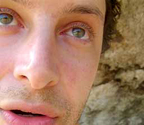
Interview of Yury Gitman
Yury Gitman is a designer, inventor, an award-winning artist (Noderunner received an Ars Electronica Golden Nica for Net Vision in 2003) and I owe him one of my first posts on the blog. It was a story about Magicbike, the bicycle turned mobile WiFi hotspot for up to 250 users in a radius of 30 meters indoors and 100 meters outdoors. A network of his Magicbikes allowed him to be one of the first people to use the Internet from inside the New York subway. Yury is also teaching at the Parsons Design + Technology Program and last year, he opened a product design company called Banana Design Lab [...]
Last week I just launched a net.art work commissioned by Turbulence, My Beating Blog. It's an experiment with the near future of blogging, in which I infuse increasingly commonplace biofeedback technology with blogging. It's a simple experiment where I'm anticipating the crafty convergence of a set of technologies before they actually fuse in the mainstream. I think we'll see blogs like that become more common place in the next couple of years. Doing work like this, with emerging mediums, often gestates into insights about the expressive capabilities of these mediums [...] [blogged by Régine on we-make-money-not-art]
Posted by jo at 04:12 PM | Comments (0)
GeoTracing
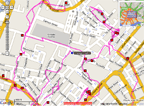
Live Reporting from Futuresonic
Waag Society is doing live reporting from Futuresonic using the GeoTracing TraceLand testbed application. GeoTracing is a software platform for creating multimedial geo-applications. What these applications have in common is that they allow you to tell your multimedial story via your movement through the landscape, whether on foot, skates, by bike or other means.
Posted by jo at 04:04 PM | Comments (0)
Leonardo Electronic Almanac
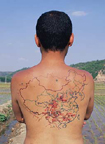
LOCATIVE MEDIA SPECIAL ISSUE
LOCATIVE MEDIA SPECIAL ISSUE; Guest Edited by Drew Hemment: A special issue of LEA, announced at the first event of the Pervasive and Locative Arts Network (PLAN) at ICA, London in 2005, is released to coincide with the final exhibition and conference of PLAN during Futuresonic 2006, Manchester, this weekend.
LOCATIVE MEDIA ESSAYS; Edited by Drew Hemment -- Anne Galloway and Matt Ward: Locative Media as socialising and spatializing practice :: Alison Sant: Mapping The Emerging Urban Landscape :: Leslie Sharpe: Swimming In The Grey Zones :: Lily Shirvanee: Locative Viscosity: Traces Of Social Histories In Public Space :: Julian Bleecker and Jeff Knowlton: A Brief Bibliography And Taxonomy of Gps-Enabled Locative Media :: Malcolm Mccullough: On Urban Markup: Frames Of Reference In Location Models For Participatory Urbanism :: Michele Chang and Elizabeth Goodman: Asphalt Games: Enacting Place Through Locative Media :: Steve Benford, Martin Flintham, Adam Drodz, Nick Tandavanitj, Matt Adams and Ju Row Farr: The Design And Experience Of The Location-Based Performance Uncle Roy All Around You :: Lalya Gaye and and Lars Erik Holmquist: Performing Sonic City: Situated Creativity In Mobile Music Making: Sally-Jane Norman: Locative Media & Instantiations Of Theatrical Boundaries :: Misha Myers: Homing Devices For Unhomely Times.
LOCATIVE MEDIA GALLERY--Curated by Suhjung Hur, Annie On Ni Wan, Andrew Paterson, Locative Media, on and off the beaten track
Paula Roush Bowville Fictitious Constituency
Teri Rueb Choreography of Everyday Movement
Angela Piccini Guttersnipe: on the road to Helsinki
John Evans, Drew Hemment, Theo Humphies and Mika Raento LOCA:
Location Oriented Critical Arts
Qin Ga Long March
Jesper Dyrehauge, Marie Markman and Nis Romer Planteundersøgelser Taeyoon Choi in collaboration with I&P Media Art Team Shoot me if you
can
Jang-Won Lee sunTracer
Mark Shepard Tactical Sound Garden
Erica Block and Hilary Ramsden The Walking Project: Desire Lines,
Walking and Mapping Across Continents
LOCATIVE MEDIA CURRICULUM AND BIBLIOGRAPHY: Collaboratively developed by Drew Hemment, Steve Bull, Elizabeth Goodman, Pete Gomes, Derek Hales, Hana Iverson, Paula Levine, Lorna MacDonald, Ian MacColl, Ann Morrison, Teri Rueb, Alison Sant, Leslie Sharpe, Jen Southern, Nick West and Nisar Keshvani.
MIT Press Journals
Five Cambridge Center, Cambridge, MA 02142
phone: 617-253-2889 / fax: 617-577-1545 / journals-orders@mit.edu
art / science / technology
http://lea.mit.edu
lea[at]mitpress.mit.edu
Leonardo Electronic Almanac (ISSN: 1071 4391)
Nisar Keshvani, Editor-in-Chief
Established in 1993, Leonardo Electronic Almanac (ISSN No: 1071-4391) is, jointly produced by Leonardo, the International Society for the Arts, Sciences and Technology (ISAST), and published by MIT Press, is an electronic journal dedicated to providing a forum for those who are interested in the realm where art, science and technology converge. For over a decade, LEA has thrived as an international peer reviewed electronic journal and web archive covering the interaction of the arts, sciences, and technology. LEA emphasizes rapid publication of recent work and critical discussion on topics of current excitement with a slant on shorter, less academic texts. Many contributors are younger scholars, artists, scientists, educators and developers of new technological resources in the media arts.
Posted by jo at 03:42 PM | Comments (0)
The4thScreen: A Global Festival of Art & Innovation for Mobile Phones
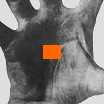
Deadline Extended
The4thScreen: Global Festival of Art & Innovation for Mobile Phones: The extended deadline for submissions to the The4thScreen festival is coming up in five days, on July 25.
The entries will be judged by our distinguished Jury: Laurie Anderson, Jacqueline Bosnjak, J.C. Herz, Warrington Hudlin, Surj Patel, Eric Paulos, Paul Miller aka DJ Spooky, Christiane Paul, Holly Willis. (more information about the Jury)
There will be a presentation of selected entries on Sunday July 30 at 8pm at the 'Scanners': The 2006 New York Video Festival. A co-presentation of the Film Society and Lincoln Center Festival 2006.
The4thScreen Festival'06 is produced by Postmasters Productions in partnership with the Museum of the Moving Image and Polytechnic University, New York.
contact: Tamas Banovich, Festival Director
tamas[at]The4thScreen.net
The4thScreen
459 W19 Street New York, NY10011 USA
phone: 212 229 9736
mobile: 917 400 2381
http://The4thScreen.net
Posted by jo at 07:28 AM | Comments (0)
July 20, 2006
Meta Morphic "Living" Architecture

Why can't architecture grow with us?
Digitally-aided technology can be imbedded in the creation of new, living systems. Recent advancements in the production of living materials and in the logic behind the kinetics of robots have brought both fields closer together, and have begun to blur the lines of what we think of as "living." Robots made of parts that can communicate with each other act the same as living materials, and should be considered "alive" because they can respond to changing information (conditions), much like living materials can.
Digital technology, and the mechanics that allow spaces to be kinetic, should be embedded in the physical architecture we live in. The form of Architecture should not be predetermined, instead Architecture should play a more active role in suggesting new ways for its inhabitants to use space based on real time information exchanges. Recently, technological advancements have been made in robotic fields that look at new ways of designing systems to be more interactive. We should employ this way of thinking when we design the relationships of the parts that make up interactive space. Spaces should be constructed of parts that have the ability to communicate with one another and constantly reshape our experience. -- Robert Miles Kemp [via Interactive Architecture]
Posted by jo at 09:54 AM | Comments (0)
Shapeshifters

Morphing Objects and Transforming Interfaces
...Talking to the Hand: an exploration into the interactive qualities of shape shifting technologies by Oren Horev, explores morphing objects and transforming interfaces. The project is driven by the thought that by changing their shape, computers and digital objects can provide the user with a clear understanding of their status, both tactilely and visually.
The first object developed to illustrate the concept is the cube-shaped InSync hard drive. It indicates the level of synchronization (percentage) with the source computer by twisting itself, misaligning its shape. The less overlap between the two file structures, the more the hard drive twists. To synchronize the drive and computer the user either clicks a button on the screen or nudges the mechanism itself to initiate the alignment.
The second object is a a sort of mouse / touch panel hybrid called Terrain of Information. Moving the touch pad controls the on-screen cursor. Simultaneously the surface of the touch pad morphs in relation to the objects and applications being pointed at. It shows hidden qualities of an object, a big or small bump, for example, represents the size of a folder, while a rhythmic movement indicates the beat of an Internet radio station. The prototype is composed of a pin-pad and a screen application. The pin pad morphing is emulated by a micro-controlled robotic arm running beneath. A processing application (Java) manages the icons on screen and the kinetic calculations.
The last prototype is the TactoPhone with an active 3D surface that animates and displays shapes (video). The phone interface allows for interaction with location based information “on the go” and “In the pocket”. Video scenario 1: the user sets his phone to alert him of nearby events; video scenario 2: the phone tracks the location of people.
Talking to the Hand suggests that shape shifting technologies could bring our current familiarity and comfort with physical objects into the virtual world, creating a more integrated experience.
More in Horev's thesis blog: Shapeshifters and in the PDF of his research... [blogged by Régine on we-make-money-not-art]
Posted by jo at 09:37 AM | Comments (0)
15x15
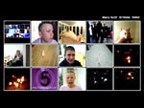
Homage to Warhol
In 1968 Andy Warhol stated that; In the future, everyone will be world-famous for 15 minutes. Using Warhol’s statement as a premise, 15x15 advances the statement into the 21st century; with new media technology anyone and everyone can be world famous. For 15 seconds...
Participants can contribute to the piece using a standard mobile camera phone that can capture video, and can send video clips directly from their camera phone using MMS (Multimedia Message Service), via email or upload from your personal computer to the online database www.15x15.org or email me[at]15x15.org
The clips should be the standard video setting for a cameraphone, 176 x 144 and can be longer than 15 seconds but will be reduced to that length, participants can send as many clips as they wish. The clips can be portraits, experiential, vignettes, experimental, anything within reason, from the banal to the downright bizarre!
The viewable artwork is an interface consisting of 15 individual rectangular screens, each individual screen displays a random video clip stored within the database for a 15 second duration: 15x15. In the 21st century art is being fundamentally realigned for anyone and everyone. 15x15 is a homage to Warhol, a realisation of the artistic utilisation of new media technology and the democratisation of art in the age of digital production.
Technical requirements: Requires fast internet connection and fast computer (processor) and Flash 8 plugin. The piece can be viewed on a monitor but is best viewed as a projected piece.
Richard Vickers, Oliver Dore, Greg Brant, Hull School of Art & Design, University of Lincoln, United Kingdom.
Posted by jo at 08:31 AM | Comments (0)
July 19, 2006
Second Life Live Concert

Virtual Vega
"Back in the early 90s, an engineer named Karl Brandenburg was wracking his brain for a way to compress music files without losing their quality, when an insistent, dulcet a capella voice came drifting toward him up the hallway of the German Aerospace Center. It was rich and soft but imperfect in a way that made the singer unique, and it gave Brandenburg an instant intuition: if he could digitize it while still retaining the artist's soul, so to speak, he would have his ideal file format. The song was "Tom's Diner", the singer was Suzanne Vega, and it's why the New York musician is sometimes referred to as "the mother of MP3", the file format that made the flowering of music culture across the Internet possible.
So it seems fitting that Suzanne Vega will become the first established musician to have her entire persona uploaded onto the Internet, too. News of her performing a live concert in Second Life has already reached the SL blogosphere (as here), but when I read that news, I wanted to meet Vega's avatar for myself -- and see, so to speak, how well they'd captured her soul...
..."So how will the live show with Suzanne actually go down?" I ask Quirky, skeptical. "Will she control her avatar?"
"Yes, she will, as much as one can while simultaneously playing and singing! But she will inhabit it. She's very excited about that." I ask her if Vega's had an orientation with the complex user interface, and that question comes from personal experience, knowing how difficult it was to manuever a Pentagon advisor and a Stanford professor through the metaverse. "We still have a couple of weeks," Quirky tells me gamely, "and have already discussed that with her and the other guests."
Suzanne Vega's avatar is the work of famed in-world designer Munchflower Zaius, now busy completing the identities of two more Infinite Mind guests who'll appear in Second Life: Internet guru Howard Rheingold, and legendary author Kurt Vonnegut. "How cool is it that the author who first speculated about the relationship between man and technology is coming here in avatar form for a chat and reading?"..." [read complete post at New World Notes]
Posted by jo at 07:27 PM | Comments (0)
justin MC THIS hammond
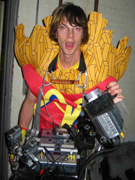
Mobility is Freedom
MC THIS- Featuring Live Mobile Video Projection @ Festivals & Screenings What is MC This? Provoking wonder, compelling, awe inspiring! In a nutshell, a patent pending, mobile video projection unit, created and performed by justin MC This hammond. MC This is the only artist in the world who has brought visual projection from the interior to the streets, rooftops, forests and deserts in one step. MC This can project live images from 4 or more video sources, mix them, add effects to them and project them anywhere he goes on a number of unique screen surfaces. MC This is innovative and technologically superior. Eye catching and jaw dropping to say the very least. MC This has done plenty of private / corporate parties and events. Incorporating live feeds of performers ,attendees, sponsors logos and layering mind-bending graphics. GUARANTEED, technical amazement for your attendees! Mobility is Freedom! [via MAKE]
Posted by jo at 06:56 PM | Comments (0)
Ruth Ron
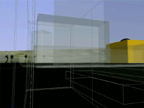
Visible City + Upgrade! Telaviv-Jerusalem
Visible City -- by Dan Collins, Dianne Hansford, and Ruth Ron -- uses Augmented Reality (AR), Mobile Computing (GPS), and 3D Simulated X-Ray Models developed in animation and CAD applications to visualize and navigate the urban core of San Jose (ISEA2006). Augmented reality (AR) in tandem with GPS-based mobile computing applications allows intuitive information browsing of location referenced information. In AR, the user's perception of the real world is enhanced by computer generated entities such as 3D objects, location markers, superimposed text, and spatialized audio. The interaction with these entities is available in real-time to provide convincing and natural feedback to the user. The coupling of Augmented Reality with location based information (GPS) and high-end 3D modeling enables the integration of virtual entities with real world objects in a seamless manner.
![]()
Ruth Ron is an architect and digital artist, whose work focuses on the extension and deformation of real space by using virtual assets. Her work explores the borders between architecture and technology, form and media. She has exhibited in New York, Seattle, Paris and Jerusalem. In her lecture, Ruth will show samples of her spatial installations, online interactive work and some current research of interface between the computer and the physical environment.
Upgrade! Tel-Aviv-Jerusalem: Monday, 24.7.06, 19:30 @Minshar, David Chachmi st. 18, Tel Aviv.
Posted by jo at 04:05 PM | Comments (0)
Intimacy and In.yer.face
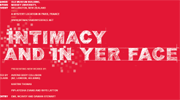
Blurring Online and Physical Performative Space
Intimacy and In.yer.face (July 20th, 8 p.m. (NZ time)) is a live performance / installation event and remix project, featuring an interdisciplinary selection of local and international artists, operating in the nexus between art and technology. Our conception of site is fragmented when agents participate from spatially dispersed locations, and when the boundaries between online and physical performative space are blurred. Intimacy and In.yer.face explores this fragmentation, the endless and cyclical encoding and decoding of information that occurs in the interface between humans and machines.
Curated by Daniel Agnihotri-Clark, Intimacy and In.yer.face commences with a one-night event featuring simultaneous live performances and interactive installations, linked by real-time streaming of audio and video signals which will be broadcast over the internet. The event will feature new works by the globally dispersed cyberformance troupe Avatar Body Collision (New Zealand, London, Helsinki), the interdisciplinary artist Kartini Thomas (Wellington), aerialists / actors Pipi-Ayesha Evans and Rhys Latton (Wellington), and audio / video artists Emil McAvoy and Damian Stewart (Wellington).
The performance/installation event will take place on July 20th in the former Dominion Museum Building, Wellington (8 p.m. NZ time), at a mystery location in Paris (10 a.m. FR time), and everywhere else via http://www.intimacyandinyerface.net. Intimacy and In.yer.face is truly a simultaneously local and global event, pushing the understandings of site and indeterminate modes of performance practice in the interface with technology. Intimacy and In.Yer.Face follows last year's Indeterminacy and Interface - the first of performance event curated by Daniel. These projects form a significant component of his on-going doctoral research at the Massey University School of Fine Arts.
Following the performance / installation event, an open call for remix will expand the role of the audience, facilitating active participation and dialogue. Audio and video files will be available for download from the website. This remixed material will then be collated into a limited edition DVD release.
For full information about the project and the artists involved please see
http://www.intimacyandinyerface.net
Intimacy and In.yer.face
July 20th, 8 p.m. (NZ time)
Old Museum Building, Buckle St, Wellington, New Zealand
and Mystery Location, Paris
and http://www.intimacyandinyerface.net
Online Soiree
http://www.intimacyandinyerface.net
10 a.m. - 12 noon NZ time/ 10 p.m. - 12 a.m. FR time
Artist/Curator talk
School of Fine Arts seminar room, Block 2, Level C, via Gate C, Wallace St.
12.15 p.m.
For further information, images or to arrange an interview with the participants please contact: Louise Menzies, on tel: 04 801 2794 x6197, email: L.C.Menzies[at]massey.ac.nz. or Aaron Kreilser on tel: 04 8012794 x6341, email: A.P.Kreisler[at]massey.ac.nz.
Posted by jo at 02:33 PM | Comments (0)
July 18, 2006
Turbulence Commission:
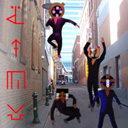
SWM05: Distributed Bodies of Musical-Visual Form
SWM05: Distributed Bodies of Musical-Visual Form [SWM05] -- by Troy Innocent and Ollie Olsen with the Shaolin Wooden Men and Harry Lee -- features the distributed bodies of musical-visual form that are inhabited by the Shaolin Wooden Men (SWM), a virtual band, a 'gang of numbers' -- me(a)tacodeflesh. SWM require your assistance to manifest as media creatures. They invite you to send them images of your local environment in which they can appear. Sending images unlocks access to the SWM05 mobile site which consists of downloadable micromusic ringtones and small screen machinima performances. The SWM are everywhere. In a meshwork of wireless entities, they are media creatures seeking a fragmented existence to be consumed in the nanoseconds of play-time in the emerging wireless net. SWM05 will transfigure the SWM by embodying them in a new materiality.
SWM05: Distributed Bodies of Musical-Visual Form is a 2005 commission of New Radio and Performing Arts, Inc., (aka Ether-Ore) for its Turbulence web site. It was made possible with funding from the Andy Warhol Foundation for the Visual Arts.
BIOGRAPIES
The SHAOLIN WOODEN MEN are a 'gang of numbers' whose bodies are 'made of sound'. In their various manifestations they have released three full-length recordings - "S.W.M. " (1992), "The Hungry Forest" (1994) and "Supermindway" (2001) - and a collection of singles and remixed released on the Psy-Harmonics label. The S.W.M. work across image, sound and interactivity and have performed at DEAF96 and exhibited at ISEA96. Typically, they require the assistance of creative humans to manifest as media creatures to be distributed across the net.
TROY INNOCENT has been exploring the 'language of computers' and the new aesthetics of digital space since 1989. In recognition of this work, Innocent has been described as "the first philologist of virtual reality". His artificial worlds – Iconica (SIGGRAPH 98, USA), Semiomorph (ISEA02, Japan), and lifeSigns (Ars Electronica 2004, Austria) and Ludea (SIGGRAPH2006, USA) – explore the dynamic between the iconic ideal and the personal specific, the real and the simulated, and the way in which our identity is shaped by language and communication. He is currently Senior Lecturer, Department of Multimedia and Digital Arts, Monash University, Melbourne.
OLLIE OLSEN is an Australian composer, synthesist and sound designer who has been producing and performing rock, electronic and experimental music for the past thirty years. Projects include "Max Q," "NO," "Third Eye," "Orchestra of Skin and Bone," "Shaolin Wooden Men," and "I am the Server." Some recent collaborations and projects include performing with Negativland (from USA-2001); guest soloist with the Australian Art Orchestra (2002); and recording with Japanese bands, BOREDOMS and AOA (2001-2002.
HARRY LEE is a web developer working with Macromedia Flash, SQL, PHP and related technologies. Recent projects include database development for lifeSigns, exhibited at the Australian Centre for the Moving Image (ACMI) in 2004, in addition to numerous corporate and education projects. He lectures in multimedia and digital arts in the Faculty of Art & Design at Monash University.
Posted by jo at 01:06 PM | Comments (0)
Human Trials
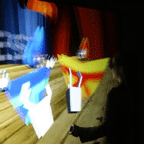
An Absurd Quest
Human Trials -- by Josephine Anstey, Dave Pape, and Sarah Bay-Chengis -- is simultaneously a public / private and embodied / disembodied performance. One user enters an immersive VR and is led on an absurd quest. The challenges appears to be about control and the choices one makes with power; but the games are rigged, the characters are duplicitous, the quest is a decoy, and the underlying test is how to cope with disempowerment. Meanwhile the experience is screened for a voyeuristic audience primed by reality TV. The audience members simultaneously watch multiple viewpoints of the virtual world, while live performers, networked into the VE, attempt to entangle the protagonist in their improvisational machinations.
The performers play two characters, Patofil and Filopat, who engage the participant in a set of overt challenges involving computer-controlled characters and dynamic virtual sets. Beyond these obvious tasks, the participant must also interpret and negotiate a subtext about world views, relationships and alliances. The participant's reactions are logged, interpreted psychologically, and affect the characters' behavior, the presentation of further challenges, and the ending. Although we expect the story to follow a basic arc based on a storyboard, our script/improvisation notes for the actors are evolving during performances.

Human Trials is designed for CAVE or CAVE-like, tracked, immersive VR systems. 3-D stereo displays with one large screen or multiple screens and/or HMDs. Ideally the participant and two human actors each enter the virtual environment from their own VR system. In effect the actors are manipulating life-size puppets since their tracking systems animate the avatars of Filopat and Patofil that the participant sees. A fall-back position is to have the actors operate their puppets from monitors without tracking systems, in this case they can still navigate their puppet wherever they need in the virtual environment.
Human Trials builds on Josephine Anstey and Dave Pape's previous experience building dramatic VR, The Thing Growing, and Networked VR projects, and Sarah Bay-Cheng's experience with drama and puppetry. Human Trials is a sister project to The Trail The Trial, experimental research focused on building intelligent agents to take the place of the human actors.
Posted by jo at 08:33 AM | Comments (0)
Battleship:GoogleEarth
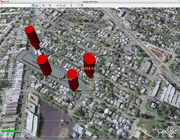
(a 1st Life/2nd Life mashup)
I've started working on a bit of summer laboratory experiment to see how Google Earth could become a platform for realtime mobile gaming. (Follow the link on the Flickr photo page to the URL you can load in your Google Earth client to see the game board in its current state.) With Google Earth open enough to place objects dynamically using the tag, a bit of SketchUp modeling and borrowing an enormous battleship model that construction dude uploaded to the SketchUp/Google 3D Warehouse, I started plugging away at a simple game mechanic based on the old Milton Bradley Battleship game.
Battleship, for those of you who never played, has a simple mechanic — two players set up their navy ships on a peg board, hidden from the other guy. You take turns plugging a peg into your side of the board, with each peg hole designated by a letter/number coordinate grid. When you plug a peg in, you say where you put it — E4! If your opponent has a ship in that coordinate (or part of one, actually), they say, sorrowfully, "Hit!" and you register that peg hole with a color to indicate a hit. If not, you just put in a neutral peg to remind you that you already tried that spot. The game continues into one player has sunk all the other guys ships.
The mechanic I'm experimenting with is simpler. One person places their ships using Google Earth and the other person goes out in the normal world with a mobile phone, a GPS connected to the mobile phone. The phone has a small Python script on it that reads the GPS and sends the data to the game engine, which then updates the Google Earth KML model showing the current state of the game grid. When the player who's trying to sink the ships wants to try for a hit, they call into the game engine and say "drop". The game reads back the coordinates at which the "peg" was dropped and shortly thereafter, the other player will see the peg appear at the coordinate it was dropped. If the peg hits one of the ships, it's a Hit, otherwise it's a miss.
Next Steps
As I continue developing the engine, I'll probably have the game engine let you know when you call in to do the "drop" whether it was a hit or not, or the opposing player can text or call to indicate the same.
I want to put in a "ping" command for the call-in battleship control center to help whoever's wandering around in the world navigate a bit. (Although the game is only really practical if you limit the boundaries over which it can be played.)
I need a lighter weight battleship — the current SketchUp model is too large, in data size terms and takes too long to initially load (although, it only needs to be loaded once.)
Goals
* Experiment with "1st Life" action reflected in "2nd Life" worlds (verso of the folly Ender suffered in Orson Scott Card's simply fascinating Ender's Game
* Learn KML
* Learn SketchUp
* Learn Python for S60
* Make a mobile/pervasive game in which one has to move around in order to play
Equipment
* Google Earth client
* Apache+Tomcat+MySQL (Java and JSP on the server-side computer)
* Nokia N70 and a little Python app to connect to the Bluetooth GPS and upload the data to the server
* Voice Application (for the battleship control center to drop/ping)
* SketchUp
Time Committed: * About 2 days learning stuff, and 1/2 a day programming the computer to make it do things.
Why do I blog this? To keep track of and share the near future laboratory experiments I'm doing this summer.
Technorati Tags: mobile, pervasive electronic games, pervasive media, play, urban play
[blogged by Julian Bleecker on research techkwondo]
Posted by jo at 08:22 AM | Comments (0)
Game/Play

Playful Interaction and Goal-Oriented Gaming
Game/Play: Playful Interaction and Goal-oriented Gaming Explored Through Media Arts Practice ::
The exhibition opens at two different venues, in the UK and then joins, to tour as a single touring show. Game/Play is a networked national touring exhibition in the UK, focusing on the rhetorical constructs game and play. This collaboration between Q Arts, Derby and HTTP Gallery, London provides a basis for exchange and interaction between audiences, artists, curators and writers through the exhibitions and networked activity.
Enjoy the Ermajello performance of Plankton at Q Arts :: test drive Mary Flanagan's [giantJoystick] at HTTP :: view the works and connect and collaborate with visitors in both :: galleries in the online :: multiuser spaces of Furtherfield's VisitorsStudio and Endless Forest by Tale of Tales.
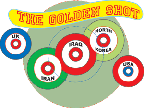
Projects fall under three main categories: installations, independent video games, and online (networked) artworks. Game/Play opens at two venues, HTTP Gallery and Q Arts. Curated by Giles Askham, Marc Garrett, Ruth Catlow, Corrado Morgana & Louise Clements.
Game/Play Artists: Michael Mateas and Andrew Stern, Jetro Lauha, Julian Oliver, Kenta Cho, Mary Flanagan, Low Brow Trash, Paul Granjon, Simon Poulter, Giles Askham, Jakub Dvorsky, Long Journey Home, PRU, Q Club, Furtherfield, Tale of Tales.
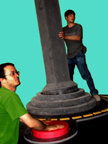
Game/Play Writers: Giles Askham / Jon Bird / Peter Bowcott / Javier Candeira / Rebecca Cannon / Ele Carpenter, Ruth Catlow, Louise Clements, Mary Flanagan, Marc Garrett, Keiron Gillen, Mark R Hancock, Martijn Hendriks, Pat Kane, Ana-Marija Koljanin, Maaike Lauwaert, Corrado Morgana, Patrick Lichty, Christiane Paul, Thomas Petersen, Andy Pollaine, Jonathan Willett.
HTTP Gallery
Saturday 22 July 7pm – 9pm.
Unit A2, Arena Business Centre,
71 Ashfield Rd, London N4 1NY
Q Arts:
21 July 6.30pm – 8.30pm Q Arts – Gallery
35/36 Queen Street,
Derby, DE1 3DS
Posted by jo at 08:05 AM | Comments (0)
July 15, 2006
Mirjam Struppek
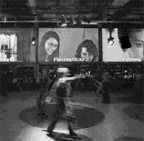
The Social Potential of Urban Screens
"...The emergence of the internet culture has brought new ways of participation and exchange to challenge hierarchical authorship. The 'new forms of creation mediated by networks more and more remote, fast and wireless' (Beiguelman, 2006) derived from this culture, influence new productions of public space. Artists are exploring the potential of the growing interconnections between online and offline worlds, and between social experiences in virtual and physical space. Wallace (2003) sees the internet connected to screens 'as a delivery mechanism to inhabit and or change actual urban spaces'. We can find various community experiments in the growing field of social computing: friend-of-a-friend communities; participatory experiments in content creation in the mailing list culture; and more recently, the wiki websites (where users can add and edit content) and blogging systems that serve an increased need for self-expression. By connecting large outdoor screens with digital experiments in online worlds, the culture of collaborative content production and networking can be brought to a wider audience for inspiration and engagement..." From The Social Potential of Urban Screens by Mirjam Struppek, Visual Communication, Volume 5, No. 2, Sage Publications June 2006, p 173-188.
Posted by jo at 02:25 PM | Comments (0)
Social Acoustics & Media Reverberation
![]()
Acoustic Experiments, Radio Art, DiY, Urban Interventions
Social Acoustics & Media Reverberation, July 19-24, Cluj :: A week of audio workshops, sound performances and film screenings :: From July 19-24, Paul Fyvolent, a radio activist, artist and writer, and Daniel Gorman, an electronic music composer, will host an interactive workshop for artists, musicians, DJs, students and other participants from Cluj interested in acoustic experiments and radio art. The workshop is organized by D Media in collaboration with AltArt, La Gazette and Tranzit House. It is part of radio.territories, a year-long project of radio art and urban interventions in Austria, Bulgaria, the Czech Republic, Estonia, Germany, Romania, Slovakia and the UK.
The workshop focuses on using do-it-yourself media for social change, using radio to build bridges from the media world to physical spaces, and using 'cultural jamming" to deconstruct existing media. Workshop participants will create site-specific acoustic portraits of Cluj - mixing the sounds of urban spaces with interviews, stories and fragments that capture (or distort) its culture and politics. The completed works will be played at clubs and public spaces in the city, broadcast on local radio and uploaded to radio.indymedia.org.
Program:
19 July, 16:00: Tranzit House, Str. G. Baritiu nr 16 :: Intro to radio.territories project & workshop. Presentation of do it yourself media practices, the history of cultural jamming, the experimental use of acoustics by artists and free radio projects in the US and Europe.
20 July – 23 July, 11:00 – 18:30: Binar Center for Digital Culture, Str. Universitatii nr 2. :: Workshop for registered participants.
21 July, 22:00: La Gazette, Str. Clinicilor nr 16 :: Screening of "Sonic Outlaws," a film by Craig Baldwin about cultural jamming. The term "jamming" comes from the practice of amateur radio pranksters who interfered with broadcasting signals. "Sonic Outlaws" documents examples of jamming from Duchamp and Warhol to Negativland - who gained underground notoriety when they were sued by copyright U2’s copyright lawyers for parodying their songs.
22 July, 22:00: La Gazette, Str. Clinicilor nr 16 :: DJs Podp (San Francisco / Berlin) and Dan Seizure (Edinburgh) mix up electronica, d+b & world beat with visuals.
23 July, Works produced during the workshop played in Cluj and broadcast on FM – times & places will be announced. Look for updates on http://www.dmedia.ro and http://romania.indymedia.org
About the invited artists:
Pod p, aka Paul Fyvolent, is a media activist, artist, writer, DJ and the host of Pan Optic Radio (a mix of audio composting and interviews with activist artists). He has worked primarily in San Francisco and Berlin, contributing audio, texts and films to Ars Electronica, Next 5 Minutes, Noborder.org, Borderland Film and Arts Festival, Resonance FM and Radio.Indymedia.org. Pod is also a writer for Faultlines and The Journal Of Aesthetics and Protest, a co-founder of the Soundlab at Cellspace in San Francisco (http://www.cellspace.org), and is active with Electronic Frontier Foundation (http://www.eff.org). His latest production site for media interventions and community organisms is http://www.xlterrestrials.org.
Danseizure, aka Daniel Gorman, works in Edinburgh as an experimental composer, creating hypnotic music by sampling and distorting sounds collected from everyday life (http://www.theforest.org.uk/music/Danseizure). In 2004 he was awarded a Grant from the Scottish Arts Council to work in a dome of an abandoned American military base in Berlin, where he reversed the dome’s original constructed purpose (to listen) to produce abstract sound compositions. The recordings were featured at Transmediale 2005 on the Soundscape Website (http://berlin.soundscape-fm.net). Dan performs at The Forest, a veggie cafe/self-organized art space in Edinburgh. For the past year he has worked in Bosnia Herzegovina as Director of Firefly International, organizing exchange projects and youth workshops.
Posted by jo at 02:00 PM | Comments (0)
Omni Zona Franca:
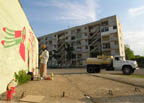
Hacktivism and Networking with a Low Budget Technology
"How does the concept of "new media" function when technology is difficult to find? Is it possible to talk about hacktivism in geographical, political and social spaces where the lack of technology prevents from developing practices and activities that involve exclusively the Internet? ...
[W]e need to construct networks within the people. Without a real internet ... working on the island (a basic internet connection costs 6 to 10 dollars an hour, about half the average Cuban salary...). For [OMNI] the network is the city, the streets; the relationship between the peoples ...
The use of digital media and their forcing are definitely hacker practices that bring communication and interactivity. The creative use of digital media, in the Island available only from the black market if you’re Cuban and have no official reason to buy it) make the work of OMNI an action of critical, conscious and highly ethic hacktivism, which brings together all the media you can use, to experiment without limits and conditions ... Naked from every superstructure, technology becomes one of the greatest ways to realize social action..." From Omni Zona Franca: Hacktivism and Networking with a Low Budget Technology by Lucrezia Cippitelli, newmediaFIX.
Posted by jo at 01:54 PM | Comments (0)
BNMI Co-production Lab:
![]()
Almost Perfect
Almost Perfect is a rapid prototyping lab that explores the creation of pervasive mobile media in the Banff region. With the dedicated support of peer advisors, technicians, and production facilities, participants can develop basic to advanced level prototypes in the areas of locative media, site specific work, telematics, audio art, and responsive environments. This residency will also explore the political and social economic contexts of locative media and the wireless spectrum. Almost Perfect is a joint venture between BNMI and HP Bristol. Prototype development will be realized through the use of GPS enabled HP iPAQs and software developed by HP Research Labs Bristol.
Program Dates: November 05, 2006 - December 02, 2006 :: Application Deadline: July 15, 2006 :: Tuition: $1,850 (CAD) (scholarships may be available for accommodation and meals) :: Peer Advisors Include: Chantal Dumas (CND), Paula Levine (CND/US), Julian Priest (DK/UK):: Additional Program Details :: How To Apply.
Posted by jo at 01:37 PM | Comments (0)
July 14, 2006
Europe Lost and Found

Join The Lost Highway Expedition
A massive movement of individuals will pass through Ljubljana, Zagreb, Novi Sad, Belgrade, Skopje, Priština, Tirana, Podgorica and Sarajevo. The expedition will generate projects, art works, networks, architecture and politics based on knowledge found along the highway. Projects developed from the expedition will lead to events in Europe and the US. LHE is a project by the School of Missing Studies and Centrala Foundation including: Azra Akšamija, Katherine Carl, Ana Dzokić, Ivan Kucina, Marc Neelen, Kyong Park, Marjetica Potrč and Srdjan Jovanović Weiss, together with partners in the cities of The Lost Highway Expedition.
The Lost Highway Expedition is a tour to explore the unknown future of Europe. It was initiated by the School of Missing Studies [SMS] as the first event of Europe Lost and Found (ELF), a multi annual and three-phased project. ELF is an interdisciplinary and multi-nationally based research project to articulate and imagine the current evolution of new and transforming borders and territories of Europe.
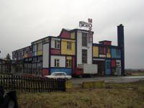
The subject is the continent of immigration, and its depopulation and aging, and the need for redefinition of states, sovereignties and citizenships. Challenged is the established belief and practice of nation-state, including non-representative and technocratic construction of European Union yet to vision more open and alternative definitions for populous in movements. The rejection of constitutional referendum and the riots in France signal the contradiction between homogeneous and multiple identities, the fluidity of capital and containment of labor, the liberation of individuals and their restrictions under sovereignty. Clearly, Europe cannot subsist by itself, and is already being redefined by "the others" in its quest for a self-identity. In such contexts, ELF suggests the future of Europe is best seen in the Western Balkan.
Posted by jo at 06:53 PM | Comments (0)
LOOKING FOR LIMINALITY IN ARCHITECTURAL SPACE
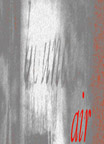
Transitional Space/The Third Space
"In this paper, I would like to connect architectural praxis with theories and practices of liminality. Liminality is a cultural and philosophical concept often used in contemporary discourse on art and spatial experience. Authors like Jonathan Hill and Gianni Vattimo also connect liminality and marginality in contemporary art practice to architecture. These authors define liminality as the conceptual, ephemeral relationships between people and spatial environments. Traditional, professional architectural practice is orientated around building procurement and objects rather than human experience, so that building users and architects who change, appropriate and subvert building agendas act as an illegal, politicised architect. Both Hill and Mitchell believe architects could supplant concerns for building objects with user experience by drawing from contemporary art practices that give priority to audience experience. The diverse practices of installation art make audience experience a central concern of the artwork.
Nevertheless, there is minimal recognition of philosophies of liminality within architectural discourse. Furthermore, and most importantly, there is little indication of how liminality may be put into practice. In this paper, I would like to begin to explore a praxis of liminality by connecting philosophies of liminality to theories and practices within contemporary of architecture and art. Praxis, here, refers to the theory-practice nexus. I would like to raise many of the difficulties associated with theories of liminality and conventional, modern architecture and art practices, as highlighted in my own, and other peoples. experiences. My aim is therefore to explore other ways of seeing architecture using the concept of liminality rather than proposing finite conclusions." From LOOKING FOR LIMINALITY IN ARCHITECTURAL SPACE by Catherine Smith.
Posted by jo at 10:30 AM | Comments (0)
[iDC] Participation
![]()
Embodiment/Disembodiment :: Privacy/Publicness
"In an earlier post I suggested the need to think through privacy, if we were to come to terms with publicness, i.e., that the two shouldn’t be unhooked. This, where privacy might be the ground or condition of entering into publicness: one factor to be considered, and we certainly don’t even need the current discussion to make this clear, is gender. But the discussion seems to be falling back on pretty familiar generalizations (and sometimes essentializations): women do A, men do B, etc. Not sure how far that gets anyone. Statistical tendencies for such a small sample group would probably require more detail: if we took only the instance of academics (forgive me, everyone else, but it came up in a post), wouldn’t we need to know how many of what genders, what age groups, what class backgrounds, how many single/heterosexual/gay, how many with dependents, how many with what kind of rank and workload? How many in each category have posted how often, who spends how much time reading the list? Not sure anyway that such a survey wouldn’t end up confirming pre-existing positions.
Am interested to note that individual accounts of relations to participation so far emphasize embodied—often very uncomfortable—positions, and while my sense is that these have mainly come from women, I’m fairly sure that many men would identify with them (I know I do). This might suggest that relations to this kind of list—and maybe the technology more generally?—rely on a complex of relations between embodiment and disembodiment, which I think occur along the border of privacy and publicness, or, more dynamically, represent their intertwining. Given that there’s a traditional pair of equations between privileged disembodiment (the disembodiment of the unmarked, the white male) and publicness, on one hand, and embodiment (typically seen as marked, feminine) and privacy, on the other, then perhaps the agitation that’s evident around participation is a sign that a) the private conditions of entry into publicness have become unstable (which may be at once liberating and alarming, for both men and women, and which is likely to be intensified by the temporal disjunctions of this mode of communication), and/or b) that new technologies cannot guarantee new cultural and ideological formations." - Frazer Ward, Department of Art, Smith College [posted on Institute for Distributed Creativity]
Posted by jo at 09:51 AM | Comments (0)
July 13, 2006
SoundWalk 2006

Call for Proposals
Taking place within the Arts District of Downtown Long Beach, SoundWalk is an annual art event, produced by the Long Beach artist group, FLOOD. During this, our third year, in addition to the main sound installation-based event on Saturday, we will offer an extra evening of performances on Friday. The sound installations will encompass a wide range of work that will integrate visual and aural elements. Included will be sculptures, environments and installations, both interactive and passive. It is the variety of work that makes this event memorable for all who participate as well as for those who attend.
"The initial impetus for SoundWalk arose from a certain ennui with the physical environment in which we function on a daily basis. Thus a question was born out of the experience of sameness with a familiar environment spawning numerous more questions. How could we make this interesting? What would make this place different? How could a change be challenging to the residents and visitors to this area? What if it sounded differently than it does?..." From Notes on SoundWalk by Frauke von der Horst
Application Deadline: August 5th
Application Fee: None
Submission requirements:
:: Resume
:: Artist Statement
:: Up to two (2) proposals or examples of previous work with:
o Sound clips (.wav, mp3 or .aiff)
o Images (hi-rez)
o Accompanying text / description
(Please indicate which previous works are available for this year’s event.) *All submissions will be reviewed and accepted by an academic and artistic panel selected by FLOOD.
Please send all submission information in digital form to: submissions[at]soundwalk.org
Posted by jo at 05:13 PM | Comments (0)
NEURAL N.25
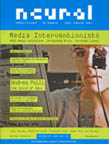
new media art. emusic. hacktivism.
NEURAL N.25: new media art .Siegfried Zielinski interview. .Olia Lialina interview. Christophe Bruno interview. .Identity in the age of digital technologies. news: Ten-sided, ten identities in a blog, Emotion's Defibrillator, consciousness short circuit, Camera Obscura 2005/1-Inf, memetic photographic virus, Confess.or, one to many confessions, Difference Engine, extracting the metaphysics from the net. reviews: ..books / dvd / cd-rom: Satellite of Love; M.Eraso, A.Ludovico, S.Krekovic - The Mag.net reader; A. Cerveira Pinto - META.morfosis; M.Jahrmann, M.Moswitzer - Ludic Society Magazine #1 + #2; T.Corby - Network Art; V. Baroni - Postcarts; J.Juul - Half-Real.
emusic .Andrea Polli interview. Snog interview. Derek Holzer interview. news: 4'04" Sound not found, Pianolina, the interactive piano, Dewanatron, cranking electronics, eShofar, folk tradition and technology, Amy e Klara, machinic male - dicta. reviews: books / dvd / cd+: A.Hugill - 'Pataphysics; Microscope Session DVD 2.0; Live Cinema 01; G.Kiers+L. van der Velden - Sonic Acts XI; AGF.3 & Sue.C - Mini Movies; V.Moorefield - The Producer as Composer; Y.Kawamura - Slide. .cd reviews: Aphex Twin, Francisco Lopez, Luc Ferrari, John Hegre & Maja Ratkje, Autechre / The Hafler Trio, Doddodo, Howard Stelzer / Giuseppe Ielasi, Jarrod Fowler, Warren Burt, Hyper, Rf, Pure, Alvars Orkester, Miller + Fiam, Rlw, Crawling With Tarts, Scatole Sonore/Impro Ensemble, Product, Incidental Amplifications, Refractions.
hacktivism .Raqs Media Collective interview. Fernando Llamos interview. Hacking Biometrics. news: Monolith, copyright hacking, Un_wiki, Wikipedia radical polemic, Movie Mapper, The Brand Hype Database, Pneumatic Parliament, instant democracy, Zone Interdite, mapping secret territories. reviews: books / dvd / cd+:F.Stalder - Open Cultures and the Nature of Networks, B.Marenko - DiY Survival, M.Gerritzen - Beautiful World, M.Vishmidt + M.A.Francis + J.Walsh + L. Sykes - Media Mutandis.
Posted by jo at 05:06 PM | Comments (0)
GLOWLAB 09: july :: august 2006

Networks, Mobility, Interventions
The projects in Glowlab 09 examine urban architecture by investigating the social spaces enabled by public networks, mobile communication devices and direct intervention. In viewing the work, one might re-imagine the city as space which is defined through the nature of the interactions that take place within it.

Public Broadcast Cart by Ricardo Miranda Zuñiga: Transforms a shopping cart into a mobile radio station, transmitting via miniFM and the Internet. The Public Broadcast Cart is designed to enable any pedestrian to become an active producer of a radio broadcast by reversing the usual role of the public from audience to producer.

Hundekopf by Brian House and Sue Huang (Knifeandfork): A location-based narrative project utilizing SMS text-messaging to explore the experience of riding the Berlin Ringbahn.

Relay: Toronto by Germaine Koh: An architectural intervention that turns a building into a sort of urban lighthouse, relaying text messages received on a mobile phone by flashing the building lights in Morse code.

Lee Walton's Western Shift by Allard van Hoorn: An open-environment collaboration between researchers, architects, designers, artist, curators and all kind of cultural producers. Its aim is to stimulate fresh ways of looking at urban living and discover alternative solutions.

SpeedWave by Otino Corsano: A photographic based performance piece inspired by the established location of a regularly monitored Toronto speed trap. A camera on a tripod replaces the laser gun to document waves of local traffic.

Talking Cities [magazine review] by Krista Jenkins: A review of the recently published Talking Cities magazine, the print accompaniment to the exhibition of the same name, taking place at Zeche Zollverein in Essen, Germany.
Glowlab is an artist-run production and publishing lab engaging urban public space as the medium for contemporary art and technology projects. We track emerging approaches to psychogeography, the exploration of the physical and psychological landscape of cities. Our annual Conflux festival, exhibitions, events and our bi-monthly web-based magazine support a network of artists, researchers and technologists around the world.
Posted by jo at 02:11 PM | Comments (0)
July 12, 2006
SEA UNSEA
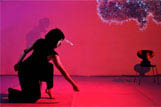
dans-architecture
Sea Unsea takes place on an interactive stage informed by a camera interface. On an empty floor and beneath a slanted cloud canopy, four performers begin by simply walking. As they cross the floor, their movements affect a sonorous field of sound while tides of virtual sea meadows are projected onto the canopy above. Capturing the fleeting forms of this virtual sea, the performers play and explore, attracting, repulsing and entwining their bodies and voices within the evolving patterns of a swirling hynotic synthetic sea. Testing the physical and emotional thresholds that separate them from the rootless sea meadow the work develops through repetitive tides of action. Across time the sea gradually evolves as a growing ecology embedding the presence of the performers as mnemonic traces within a dense field.
Sea Unsea is an interactive dans-architecture conceived by between architect Mette Ramsgard Thomsen and choreographer Carol Brown and developed in collaboration with Chiron Mottram and Alan Penn from the Virtual Reality Centre for the Built Environment, Bartlett School of Architecture, University College London.
Sea Unsea builds on Carol Brown and Mette Ramsgard Thomsen's former collaborations, The Changing Room and Spawn.
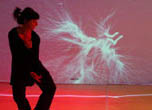
Research Questions: Sea Unsea explores new intersections between embodied interface design and an intelligent digital environment. By adapting the Virtual Reality Centre's crowd visualisation software, we are investigating the making of a digital ecology of virtual agents acting and reacting on the presence of the performer. The agents can be understood as a swarm of digital beings that interact with each other as well as react to changes in their environment. Defined by low-level rules that lead to the emergence of a high-level patterning, the agents inhabit the two dimensional surface of the camera picture plane. As they seek to navigate the plane, drawn by defined points of attraction, and hindered by shades of darkness, they encounter the performers, negotiating their presence, confronting, traversing, intersecting or evading their image.
Posted by jo at 07:09 PM | Comments (0)
Digital Arts and Culture: The Future of Digital Media Culture
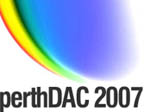
Call for Papers
Conference Dates: 15 - 18th September 2007: Digital Arts and Culture (DAC) is the leading cross-disciplinary scholarly/research conference series for the analysis of developments in the broad field of digital media, expression and communication. DAC will be hosted as the key international conference in the public program of the Biennale of Electronic Arts Perth (BEAP) in Perth, Australia. BEAP celebrates and critiques new and novel technologies (digital, bio, nano, other) by showcasing artworks made with, or are about, new technologies. perthDAC's conference program will be closely inter-woven with BEAP's exhibitions.
Theme: In the early 1990s, the very term digital was new and novel. However, it has taken only fifteen years for e-mail, the Internet, mobile phones, the power of searchable databases, games, film and TV special effects and workplace software tools to become a common and essential part of modern life. Research has not only described the arrival of these new forms, but is increasingly addressing the unexpected social and cultural uses of digital communications and virtual work/play environments.
In the same historically brief time, popular attention has turned to the potentials and problems of the newer new technologies, bio and nano. In addition, the global phenomenon of terrorism, super-epidemics and climate change have developed from distant concerns to everyday realities. Thus the context for digitally mediated processes is also very different.
perthDAC 2007 will explore the complex interaction of human behaviour and new technologies that will be The Future of Digital Media Culture.
Posted by jo at 06:50 PM | Comments (0)
Guerrilla Net Ballet Performance: Ballettikka Internettikka:
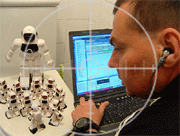
VolksNetBallet
Guerrilla Net Ballet Performance: Ballettikka Internettikka: VolksNetBallet by Igor Stromajer & Brane Zorman :: People's Internet Ballet furtively performed at -- and secretly broadcasted (as six one-minute live streaming videos) from -- the Basement Toilet in Volksbühne at Rosa-Luxemburg Square in Berlin, Germany; # Latitude: 52.31.36.84 N, Longitude: 13.24.43.02 E, Terrain Elevation: 41 m on Sunday, July 9th 2006 at 9 PM GMT+1 (Berlin/Paris local time). "Stromajer and Zorman manipulated a semi-automatic flying cow and eleven robots dancing an internet ballet, MC Brane conducted an MP3 orchestra!"
VolksNetBallet was broadcast in the form of six one-minute streaming videos, almost live, with only two minutes delay. It means that the visitors could see and hear in six steps what had just happened only two minutes earlier during the VolksNetBallet in Volksbühne Basement Toilet. All six videos were edited live in-camera, using only STOP and REC functions, then immediately converted to Real Media files using Real Producer, and finally, transferred to the server for viewing.
Ballettikka Internettikka is an ongoing artistic study of the internet guerrilla performance. After invading The Bolsh.oi Theatre in Moscow (March 2002), La S.cala in Milan (November 2004) and The National Theatre in Belgrade (October 2005), Stromajer and Zorman performed a new guerrilla net ballet, this time in the men's toilet in the basement of Volksbühne Berlin. The artists utilized low-tech mobile and wireless equipment for the invasion and live broadcast: a public unprotected wireless internet connection point (wLAN), available for free at the Rosa-Luxemburg Square in Berlin (ID: Helmut22; signal strength in the basement of Volksbühne: 2/5), free RealProducer (version 11.0) and Live LE software for streaming video and audio live manipulation. Ballettikka Internettikka: VolksNetBallet took place on the very same evening and at the very same time as another huge people's festivity -- the final match of the World Soccer Cup 2006, which also took place in Germany.
Dancing a wireless people's internet ballet in Volksbühne Berlin represented a big conceptual and strategic challenge to the Intima Virtual Base and all the collaborators, therefore, the preparations were taken seriously, safety measures were calculated, and the previous experiences from the Bolsh.oi Theatre in Moscow, La S.cala in Milan and The National Theatre in Belgrade were very welcome.
Note: Volksbühne Berlin did not voluntarily co-operate in the project, but was selected based on the conceptual strategy of the project. The management of the Volksbühne Berlin was not a co-producer of this project and did not co-operate in the process of its realization.
Posted by jo at 06:13 PM | Comments (0)
NEXT YASMIN HOT TOPIC:
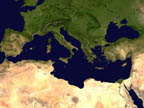
EDUCATIONAL ISSUES AROUND MEDITERRANEAN RIM
"One of the questions that comes to mind is the difference between teaching in a context where new media technologies are being invented and developed, as compared to teaching in a context where there are few local R and D or technology development companies or laboratories; i.e. how do you teach in a context that consumes inventions basically developed elsewhere?
Scientists and engineers like to say that science and technology are "neutral" but of course the use of science and technology are socially embedded. Not only is access to science and technology an issue in many places, but the agenda for new science and technology is often set in places very distant to address priorities that are different from local priorities.
For instance the way that the computer game and mobile phone industries are now setting the research agendas is not driven by local needs but by global market share, and only the open source and other movements are addressing other research agendas. An important idea for me is that the direction that science and technology is not some inevitable process; it is a process that is driven by a combination of the dreams of inventors and their access to funding to develop their ideas.
And here we have to ackowledge that a language is a not a neutral context;
if you choose to teach in a non english language, do you have access to the teaching materials you need? What language do you teach new media in and how does this contextualise what can and cannot be taught?" Roger Malina, YASMIN
Posted by jo at 10:02 AM | Comments (0)
LAb[au]
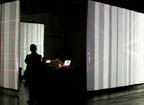
LIQUID SPACE 04 Workshop
LAb[au] is pleased to announce LIQUID SPACE 04 a workshop on interactive spatial audiovisuals with the specific theme of co/ordinate space. The workshop will take place from August 31 to September 22, 2006 at the Center for Visual Arts TENT, Rotterdam, The Netherlands in the context of the exhibition Neo-beginners|open Rotterdam, initiated by Reinaart Vanhoe.
Liquid Space is a series of artistic workshops LAb[au] has realized in the past three years to design spatial audiovisuals with a specific focus on collaborative design processes. Each design cycle stands under a specific theme, theoretic approach, to frame the work on the interactive, immersive and performative qualities of digital design whereas its results lead to installations, exhibitions and performances. In the context of Liquid Space, LAb[au] also conceived a hypertextual catalogue transcribing these interactive 360 multiscreen and quadraphonic real-time constructs into a 2D concept. The dvd-book is a visual, theoretic and sonic collection of spatial audiovisuals created by LAb[au] in collaboration with over 30 artists from all over the world.
lqs01: deSIGNforms _ Nabi Art Center, Seoul 2003 ...>
lqs02: deSIGNing by numbers _ MediaRuimte, Brussels - 2004 ...>
lqs03: deSIGNing feedback loop systems _ Brakke Grond, Amsterdam - 2005 ...>
lqs 01/02 dvd book...> For the collaborative design workshop the space navigable music platform, a 3D engine developed by LAb[au], is proposed to the invited artists as starting-point for development and exchange. The engine is based on the principle of integrating different media in a structural, programmed manner (parameter design), inside and through electronic space / navigation. In this manner the design platform proposes rather space- than time-based logics of visual and sonic media, it is composing and editing inside 3d space to create visual and sonic architectures. An environment where the performer navigates his created 3D space to compose music in real time, displayed in a 360 projection space and quadra-phonic sound.
Liquid Space 04: [ general approach ]
The topic of the workshop is designing spatial audiovisual music, or in short: how to produce an artwork where music and visuals merge, through to the concept of space. Here movie making techniques, music composition and architectural structural practices merge.
Interdependency of sounds and visuals opens a new range of experiments, considering the digital nature of the work which permits both real-time and interactive manipulation, inscribing itself in a new artistic register of designing processes and systems, rather than closed results. Liquid space thus stands for the setting of interactive sonic and visual processes as a transdiciplinary approach, but also as an explorative work in merging codes and signs of different media. In this sense, the workshop focuses on the production of interactive 3D real time spatial and visual music projects, which take in account different performative settings, such as live concerts, user interaction, interfacing and exhibition installation.
Liquid Space 04: [ theme ]
The liquid space 04 cycle stands under the specific theme of co/ordinate space.
As the title already suggests the main concern of the workshop are the spatial logics involved in digital design, since working on visual and sonic architectures is not only the spatial structuring of information and communication processes, but also a concern of hardware interfacing and its scenography. In this sense, coordinates stands for the spatial logics of programming, its semantics and its visualisation logics proposed through the space navigable music platform, whereas coordination stands for the coherency in the interplay of different spatial concepts binding 3d real-time constructs to the design of specific hardware interfaces, its protocols and dataflows, as its spatial display, the scenography. In this manner the theme of Co/ordinate space focus on architectural concepts binding electronic and physical space as it questions the way we interact and perceive inside these constructs integrating any form of visual, sonic media. Further coordination outlines one of the main focuses of the liquid space workshop the setting up of collaborative design processes.
Liquid Space 04: [ practical ]
Submissions are being solicited from artists ( visual artists, musicians, graphic designers, programmers, architects, video and media artists ) who have a developed interest in the aims and theme of the workshop. A biography plus media can be send to lab-au@lab-au.com.
Deadline for submission: 10th of August
A selection of 10 participants will be made by LAb[au] and Reinaart Vanhoe (curator). Selected artists will be notified on the 11th of August.
The workshop will be held in English. Participants should bring their own labtop / desktop. Technological skills are not a condition for participation, though will be taken in account for the selection.
Accomodation for the participants isarranged on the expense of the organiser.
Posted by jo at 09:35 AM | Comments (0)
Live at Cabaret Voltaire Tonight!
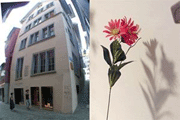
Motion Still Life 01
Motion Still Life 01 -- by Will Pappenheimer -- goes live online at Cabaret Voltaire, Zurich, July 12 ::
log in, tune out :: inhabit many still lives :: be patient or disorganized :: network is slow but dada is quick ::
July 12 - July 15 :: Digital Art Weeks :: ETH Computer Systems Institute :: Cabaret Voltaire ::
UTC/GMT+2, worldclock ::
NYC: 06:00am (EDT) Zurich: 12:00pm (CEST)
NYC: 11:00am (EDT) Zurich: 05:00pm (CEST)
Posted by jo at 06:19 AM | Comments (0)
July 11, 2006
mimoSa
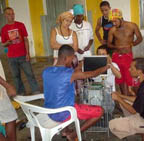
Urban Intervention and Information Correction Machine
mimoSa: Urban Intervention and Information Correction Machine began as "a continuous workshop that moves around Brazilian cities collecting people's stories using recycled and reconstructed technologies." The stated goal of the project was to "alter the Brazilian mediascape." After a false start in Rio de Janeiro in late 2005, mimoSa took root in Cachoeira, Bahia, close to Salvador (Brazil's first capital). The intent was for mimoSa to be portable, however, early on project organizers realized that it made more sense to create multiple local mimoSas (Tatiana Wells).
A mere six months later there are five additional mimoSas, two in Sao Paulo, and others in Curitiba, Tibau do Sul, and Santarem. There are now eighteen "closely involved" individuals who build, promote, and archive the multimedia, and some of these individuals have small groups who regularly assist them.
mimoSa won a Beyond award at memefest 2006 and will be participating in Futuresonic 2006. Two core members of the original group, Ricardo Ruiz and Tatiana Wells helped get Upgrade! Salvador underway; Jose Balbino and Tininha Llanos are now responsible for running the node as well as mimoSa Salvador.
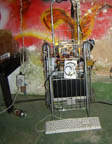
More about mimoSa
During the workshops groups of artists, programmers, and activists create and operate the machine. It records stories, stores them in a database, broadcasts them on FM, and records them to CD. It also prints telephone numbers and instructions on city streets and walls so that people passing by are able to access the stories via their mobile phones. mimoSa maps these activities via its web portal from which visitors can access both audio and video interviews.
"...mimoSa is also the machine constructed during these workshops, where the machine object is embodied, humanized..." (Ricardo Ruiz)
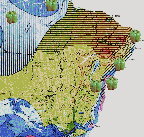
"mimoSa: Urban Intervention and Information Correctional Machine" is a 2005 commission of New Radio and Performing Arts, Inc., (aka Ether-Ore) for its Turbulence web site. It was made possible with funding from the Andy Warhol Foundation for the Visual Arts.
mimoSa is a midiatatica.org action
ALEXANDRE FREIRE: mobile programmer, responsible for setting up the audio mobile server.
ETIENNE DELACROIX: MIT fellow and teacher at University of Sao Paulo. Works with discarded computers and other technological garbage. Responsible for assembly of a portable PC and the machine's backbone.
GIULIANO DJAHDJAH: free-radio practitioner and documentarian, responsible for workshops and urban interventions.
LUÍS "ASA" FAGUNDES: hacker, PHP, C++ programmer.
MURMUR: a group collecting personal stories on mobile phones in Toronto, Canada. Responsible for mobile connectivity.
RICARDO RUIZ: media practitioner, responsible for workshops, construction of the machine and urban interventions.
ROMANO: radio artist and audio designer, responsible for audio recording.
TATIANA WELLS: new media researcher, responsible for urban interventions and collecting stories.
Posted by jo at 04:54 PM | Comments (0)
x.meda
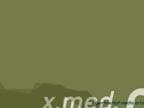
Experimental Media Arts
x.meda [PDF] (edited by) Maja Kuzmanovic, Nadine, Annemie Maes, Yves Bernard :: Paper is meant to last and this printed annual anthology of media art projects and experiences, originating in Belgium, is even more valuable because it's focused on the outcomes of a specific territory. Edited by four networked media art organizations of Brussels (nadine, okno, FoAM and iMAL), the content is a collection of knowledge and experience sharing, written by artists and pratictioneers explaining the tools they use and their own background philosophy production methods. Many workshops, in fact, disperse their content only to participants, losing the opportunity to distribute the (sometimes surprising) collective results to a more vast audience. This is the case, with some intriguing collaborations that more than often join design requirements with the open source liberating spirit and powerful tools. The presented experiments ranges from poetry composed with Pure Data to interfaces made with crochets, from audio responsive electroluminescent potatoes to speech synth for artificial singer, and as a whole they are a very peculiar and critical mass of locally conceived / globally enjoyable works. [posted on Neural]
Posted by jo at 10:17 AM | Comments (0)
Simon Elvins' Silent London
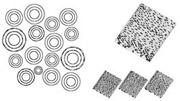
Mapping Sound
Simon Elvins is concerned with sound as an ubiquitous force. Through a series of projects he has been documenting how sound is an often ignored dimension of our physical environment. Silent London plots quiet spaces in the English capitol using noise level data. An embossed print shows quiet areas raised up from the paper, bringing them to the attention of the viewer, while noise areas become blanked out valleys. noisy areas raised up from the paper while quiet areas become blank areas of peace. His FM Radio Map serves a dual purpose. On the one hand it plots the physical locations of commercial and pirate FM radio stations broadcasting in London. But circuits conductive pencil lines placed on the back of the map also turns it into a physical interface. Using a modified radio the map can be aurally “navigated” by placing metail contacts on points on the map.
These projects are poetic but ultimately functional. Taking a conceptual design approach (Elvins studied Communication Art & Design at the Royal College of Art), they present numerical data in an aesthetic context. By choosing low-tech materials (paper, electronics) Elvins creates fragile objects whose material qualities belie their sophisticated technical content.
Simon Elvins is concerned with sound as an ubiquitous force. Through a series of projects he has been documenting how sound is an often ignored dimension of our physical environment. Silent London plots quiet spaces in the English capitol using noise level data. An embossed print shows quiet areas raised up from the paper, bringing them to the attention of the viewer, while noise areas become blanked out valleys. noisy areas raised up from the paper while quiet areas become blank areas of peace. His FM Radio Map serves a dual purpose. On the one hand it plots the physical locations of commercial and pirate FM radio stations broadcasting in London. But circuits conductive pencil lines placed on the back of the map also turns it into a physical interface. Using a modified radio the map can be aurally “navigated” by placing metail contacts on points on the map.
These projects are poetic but ultimately functional. Taking a conceptual design approach (Elvins studied Communication Art & Design at the Royal College of Art), they present numerical data in an aesthetic context. By choosing low-tech materials (paper, electronics) Elvins creates fragile objects whose material qualities belie their sophisticated technical content.
Parallel to Elvin’s interest in sound is his fascination with mapping of physical and intangible forces. Both the aforementioned projects are classic mapping projects, while Notation is a more abstract exploration of how sound can be represented visually as marks on paper. Reminiscent of experiments with graphic notation (see Eno etc), the project consists of studies of representations of tonal patterns using pencil on paper.
The Notation project page seems to indicate that these drawings can ultimately be used to produce sound, but no details are available. If so, it would be an inversion of Elvin’s excellent Paper Record Player, where he constructed a functional record player out of paper, complete with its own conical paper amplifier.
(Thanks to TomC. See also Mount Fear.) [blogged by Marius on Generator.x]
Posted by jo at 09:24 AM | Comments (0)
July 10, 2006
[iDC] Mobile Phones and The Networked Posse

Cultural and Regional Conditions
"To what extent are our concerns regarding the Networked Public Sphere tied to a specific historical phase (or regional condition) of the Internet? How are these concerns problematized by way mobile communications and wireless networks have evolved since the mid-late 90s?
I'm writing this from Tokyo where I'm with a group of architecture students studying the city as part of a study abroad program. One difference noticeable here is the way people access and use the Internet. Free wifi access is hard to find, and virtually no one is seen working on a laptop in cafes. Internet cafes here are cavernous spaces normally one or two floors below ground, consisting of stalls containing a desktop computer occupied by someone playing World of Warcraft, sofas for couples playing PSP at dedicated media stations, and racks of comics for casual reading. They also appear to be popular places for napping.
As Mimi Ito notes in "Personal, Portable, Pedestrian: Mobile Phones in Japanese Life" (MIT, 2005), a majority of Japanese access the Internet via their mobile phones, rather than a laptop or desktop computer. The Japanese word for mobile phone – keitai, roughly translated as "something you carry with you" – provides a clue to its role within Japanese culture. In contrast to “the cellular phone” of the US (defined by technical infrastructure), and “the mobile” of the UK (defined by the untethering from fixed location), the Japanese term “keitai” references a somewhat different set of parameters.
Here, the keitai is truly ubiquitous. Tokyo’s Shibuya crossing, for example, claims the highest density of mobile phone use in the world. An overwhelming majority of the Japanese population own phones equipped with digital still and video cameras, SMS (Short Message Service) messaging, wireless email and Internet browsers. Mobile phones have replaced computers as the de facto e-mail terminal of choice for many Japanese who are not in technology, finance, engineering or other computer-intensive occupations. This is particularly true for the young, who most clearly prefer handsets to laptops. These devices are used less often for voice communications than for asynchronic exchanges of text and images between close circles of friends or associates. These exchanges – often conducted throughout diverse urban spaces such as a subway car, a street corner, a shopping mall, or a grocery store aisle – interject new forms of privacy within otherwise "public" domains. Kenichi Fujimoto refers to the devices themselves as "territory machines" capable of transforming any space -- a subway train into "(one's) own room and personal paradise." While late 20th century (and predominately western) notions of the Internet promised to unlock us from the limitations of offline relationships and geographic constraints, keitai space flows in and out of ordinary, everyday activities, constantly shifting between virtual and physical realms. Here, "the" Networked Public Sphere is elided by a multiplicity of "networked posses" - small groups of close acquaintances rather than a distributed "mass" of virtual actors." Mark Shepard [posted on Institute for Distributed Creativity]
Posted by jo at 10:23 PM | Comments (0)
Chasing Pools and Sampling Ghats

HIDRAZONE ISSUE 002 X 2
Chasing the Pools is an immersive performance/installation working with integra-ting the live presence of dancers into the landscape of a multi-channel live-mix video installation. Often the two present very different viewing circumstances that remain independent of one another.
Through live-feed cameras the movement of dancers was mixed into the alpha channel of 3 video mixes. Their lit bodies became one moving image, dematerializing or re-materializing the body, while the background remained another. The dancers were able to monitor how they were affecting the composited image, essentially dancing with the image.
These channels were projected onto numerous scrims in a large tree grove. Twelve channels of sound by live musicians were mixed and spatialized throughout the site. The architecture of a tree grove naturally imposed a de-centralized structure upon the viewer where one’s experience was shaped by the act of meandering through, never being allowed a view of the whole.

Samples of the Ghats is a responsive installation that invites the audience to explore the ghats of Haridwar, India by composing themselves its audio-visual atmosphere.
A 5 metre long structure featuring a panorama of the ancient and holy city of Haridwar framed with technology is a stimulus to curiosity, an appeal to exploration. Cruising along the panel visitors soon discover that they can "play it." With the simple move of his hands he launches media sequences. They are audio and visual samples, pieces of Haridwar, collected and edited in a way to generate an atmospheric feel of the ghats.
In a collective experience, the panorama comes to life and the adventure begins.
More Hidrazone Issue 002: Performativity
Posted by jo at 07:26 PM | Comments (0)
C5 Landscape Database API 2.0

An Open Source GIS API
C5, in association with Futuresonic 2006, is proud to release the C5 Landscape Database 2.0 API to the public, in celebration of ten years of Futuresonic!
New Features in version 2.0: * Virtual Hikers * Support for GPS data such as track logs and waypoints * Ability to image GPS data onto dem data * Java3d support * Ability to read land use data (CTG files) * New analytic capabilities for landscape searching.
Version 1.0.3 features: * DEM input packages * RDBMS packages for DEM data * Support for processing DEM data dynamically * Analytic table support for landscape searching * Simple GUI (demtool) for viewing DEMs * Support for data export and management
(c) C5 corporation 2002-2006, under the GNU Lesser Public License (pre-2.0 libraries) and C5/UCSD AESTHETIC USE LICENCE (2.0 libraries: see source code for details)
Posted by jo at 06:37 PM | Comments (0)
July 08, 2006
Embodiment in the New Medias
Andrew Bucksbarg's esssay The New Mediated (Em)Body Is My Others presented at the 2nd annual U of Florida Game Studies Conference, "Video Games and the Alien / Other" is archived (a video of him reading his paper), along with other proceedings, at Gameology, an online resource for the game studies community. Abstract: "The imaginary of the networked, augmented self is unitary, but the practice of this multi-user self, this multiplicity of being in the cybernated, social dataspace is far from a cohesive, organic and maintained system. Networked identity is supplemental, like a link on a page, a page on a site, a node on a network or a server in a circuitous expanse. Not only is dataspace continually invaded by the process of this other, but this realm of media saturation requires and reproduces a myriad of othernesses that shed and collect in archives and databases. These fragments of self assault the perceived purity of identity. Networked identity embodies competing notions of fluidity and fixity, of limitation and expanse, augmentation, embodiment / disembodiment, multiplicity, temporal change and stagnation and otherness. When we think about this reflectance, we are confronted with the problematics of this newly mediated self. We are challenged with the endlessly configurable in menu options and avatars. We engage in the practice of compressing ourselves into blurb-like containers, such as "about me," and profiles that begin as templates of favorite movies and music, which need continual updating. We exist somewhere in the detritus memories of user names and passwords and abandoned email accounts collecting endless amounts of spam. We utilize the reflectance of media to both understand our use of the media and how we are extended through their use. Aside from the freshness and excitement of new media, we are left to wonder how these complex systems lack and how they also delimit us, and in this process, produce something supplemental and other. Archives of identifiers must be created and maintained; they are enacted upon us based upon corporate, gendered or racial components, but they lack in the biological. Their machinic logic is the cement from which we cannot escape and their supplement is the fracture we continuously attempt to heal. Even their evolution into the organic, the attempts at a biologic, are the offspring of this otherness, an artificial life, and an intermediate to our being. This paper presentation will take a playful, creative look at network identity and the thought process of what it means to manage multiple user names, profiles and identities and the fixity of these databases of identifiers and how this multiplicity relates to otherness, as well as intermediate states of being."
Posted by michelle at 08:02 PM
| Comments (0)
SimVeillance by Katherine Isbister and Rainey Straus : San Jose re-presents urban passersby within a game environment that mirrors a ‘real-world’ public space. The artists will recreate the Cesar Chavez plaza in downtown San Jose using the Sims 2, and will work from images captured by surveillance cameras trained on the square, to populate the simulated square with replicas of ‘real’ transients. The final installation will have two displays. On one, the game running, populated with the borrowed transients. On the other, a slide show with paired images: surveillance photo and digital snapshot of the ‘Sim’ that was created in the likeness of the real person.
Posted by jo at 06:02 PM
| Comments (0)
COMMISSIONS FOR CREATIVE PEOPLE [e.g. artists, designers, musicians and interactive media developers] WORKING DIGITALLY [e.g. interactive environments, events, physical / site specific installation and performance]: DEADLINE FOR SUBMISSIONS: 28 JULY 2006 :: Lovebytes Digital Space Commissions offer funding and exhibition opportunities for creative, digital and interactive artworks. The commissioned works will be exhibited as part of Lovebytes International Festival of Digital Art 2007, 19 - 24 March 2007, Sheffield, UK. Funding is available for the creation of new work and the completion or exhibition of existing work. Up to £5,000 (GBP) is available for each project. The aim of the commissions is to create a unique showcase for creative digital work in South Yorkshire, with the Lovebytes Festivalproviding an annual exhibition platform. There are also a range of other exhibition opportunities throughout the year. Applications are invited by email only dsp07[at]lovebytes.org.uk. Please use the application form. Supporting materials can be sent by post to: DSP 06, Lovebytes, Workstation, Sheffield, S1 2BX (We cannot return these materials, please do not send originals or valuable items).
Posted by jo at 04:40 PM
| Comments (0)
"Locative media has been attacked for being too eager to appeal to commercial interests as well as for its reliance on Cartesian mapping systems, yet if these critiques are well-founded, they are also nostalgic, invoking a notion of art as autonomous from the circuits of mass communication technologies, which we argue no longer holds. This essay begins with a survey of the development of locative media, how it has distanced itself from net art, and how it has been critically received before going on to address these critiques and ponder how the field might develop. At the 2004 Transmediale festival in Berlin, a locative media project titled .walk (dot-walk) received an honorable mention in the prestigious festival's Software Award. Developed by Utrecht-based arts collective Social Fiction, .walk combined computer code and "psychogeographic" urban exploration. Participants of .walk left the doors of the gallery to follow a randomly generated path through the city, thereby, according to Social Fiction, "calculating" the city as though it were a "peripatetic computer." The success of this simple project is representative of a larger event taking place in the media art world, in which, having left behind net art, locative media escaped the bounds of the screen to enter the city at large." Continue reading Beyond Locative Media by Marc Tuters and Kazys Varnelis.
Posted by jo at 03:57 PM
| Comments (0)
Presented by the Brisbane Festival 2006, and Centre Of Contemporary Art, Cairns and conceived and developed by Transmute Collective, Intimate Transactions is a new type of interactive installation that allows two people, located in geographically separate spaces, to interact simultaneously using only their bodies. As this highly immersive experience evolves through digital image, sound and tactile feedback, each person begins to sense their place in a complex web of relations that connects them and everything else within the work. VENUES: The Block, QUT Creative Industries Precinct, Musk Ave, kelvin Grove & Centre of Contemporary Arts Cairns. DATE & TIME: Sat 15 - Sat 22 Jul; 11am - 2pm & 3pm - 6pm daily; Individual sessions every half hour. DURATION: 30 minutes per session. TICKETS: FREE event. BOOKINGS: Brisbane: 07 3864 5495; Cairns: 07 4050 9493. Intimate Transactions has been shown extensively in Europe and Australia. It was awarded an Honorary Mention in the Prix Ars Electronica Interactive Arts category, 2005. Transmute Collective are Keith Armstrong (Director), Lisa O’Neill and Guy Webster, and numerous key collaborators.
Posted by jo at 01:15 PM
| Comments (0)
URBAN SCREENS 2007, a joint project of BBC Public Space Broadcasting, Cornerhouse Manchester, MDDA, and the Institute of Network Cultures, is seeking candidates for the CURATOR position for its 2007 conference. The post is available starting December 2006, and will be funded for one year on a freelance basis. URBAN SCREENS are interactive, dynamic digital information displays in urban environments. Forms and appearances range from LED billboards, plasma or SED screens, information displays in public transportation systems and electronic city information terminals to dynamic, intelligent surfaces that may be fully integrated into architectural façade structures. Their introduction in the urban environment poses new, unparalleled challenges and opportunities. URBAN SCREENS 2005 was the first international conference of its kind. Presentations covered a broad spectrum of topics and issues, ranging from critical theory to project experiences by researchers and practitioners in the field of art, architecture, urban studies and digital culture. URBAN SCREENS 2007 (Manchester, October 2007) will elaborate on this discussion, focusing on the potential of content: issues surrounding the production and display of media content for Urban Screens, as well as adaptive reuse of 'old' content for new media will be explored in detail. Topics will include the potential of public screens for interaction, Public Space Broadcasting (PSB), the politics of public space, mediated interaction and participation, and new participatory formats. KEY RESPONSIBILITIES To be responsible for the delivery of the conference programme through collaboration with a wide variety of artists, curators and organisations by: - Selecting presentations and art works; RESPONSIBLE TO The Board of Urban Screens Projects Ltd. KEY COMPETENCES AND QUALIFICATIONS - Extensive working experience as a curator and/or researcher; More information: TERMS: This is a freelance contract, the successful candidate will responsible for payment of his or her own taxes. Payment will be made in four instalments against pre-agreed milestones. Fee £10,000 plus reasonable expenses. The contract will be made under UK law. APPLICATIONS: To apply, please send a letter of application outlining how you meet the key competencies and have the relevant experience together with a current CV to: Cornerhouse Deadline for applications is July 21, 2006.
Posted by jo at 09:02 PM
| Comments (0)
Art in the Age of Technological Seduction: Call For Papers; Fall 2006 issue of NMC media-N: Journal of the New Media Caucus; Guest Editors: Legier Biederman and Joshua Callaghan: DEADLINE JULY 30, 2006. The fall 2006 issue of Media-N, Art in the Age of Technological Seduction, is a collaborative platform, a diverse questioning, re-considering and re-imaging of what, when and how new media arts practice is viewed by artists, practitioners, theorists, critics and historians working in the field today. We seek a broad range of contributions discussing the scope, values, and definitions of diverse new media arts practices and hope that this issue of Media-N will be a departure as much as much as an arrival. Four general questions have been posed by the members of the new media caucus as points of entry for an engaging, vibrant discussion. The issue will be divided into two sections: The first section invites brief personal accounts and anecdotal responses addressing and/or expanding one of the four questions, and we encourage everyone to respond to this section, as we’d like to include as many responses as possible. The second section invites papers that address these questions in a more lengthy and detailed form. Four Questions: 1. Defining and Re-imagining What are new media arts? Is it necessary that we define new media arts? How do we begin to discuss or teach new media arts? What sets new media arts apart from other disciplines or practices, or what connects them? What's (still) new about new media or what was, if anything ever was? What defines your work as new media art and why? How do you explain new media arts to your students and colleagues? What did or currently does attract you to new media arts practices? 2. Discourses on New Media Arts What do the discourses do to the practice? How might one describe or define the discourse/s on new media arts? How does new media arts discourse relate to new media practices? In other words, what does the discourse/s do or attempt to do to new media arts? Are theory and practice being brought together in new media arts discourse, and if not, how might we begin to do so? What do you find interesting or problematic about new media arts discourses? Do you think there is a disjuncture between new media arts practice and the discourses on it? As a new media artist, do new media arts discourses affect your practice? 3. Authorship, Relationships & Relationality Does your work maintain a traditional relationship between the artist/author/producer and the spectator/viewer? If not, how does it transgress these boundaries? Do you feel it necessary to challenge these boundaries? Do you consider relationality, the non-hierarchical intertwining of data, artwork, artists, and viewers etc., an important aspect of your work? In what context/s is your work shown and how does effect it. How do recombinatory practices commonly found in new media such as sampling, appropriation, and mash-ups, challenge traditional author/viewer conventions? While autonomy and relationality have long lineages in art history, how do they function within new media arts practices and discourses? 4. E-litism: Technospheres and the Everyday How do notions of location, language, identity, and cultural understandings of communication inform or effect new media practices? Who is left out of, disproportionately under-represented, in the world of new media art practices? Is, as some have argued, the openness often associated with information technologies and new media practices, paradoxically, replacing the national politics of a past with the global connectivity of cosmopolitan tourism? How does your particular specificity (sexual, gender, ethnic, racial, class) affect your practice, your work or its reception? Event reviews: The editorial board also invites proposals for reviews of exhibitions / events / festivals / conferences, etc. For more information: http://www.newmediacaucus.org/media-n/call.htm. [] Send manuscripts via email to: Legier Biederman (lbiederm[at]ucla.edu) by July 30, 2006 THANK YOU
Posted by jo at 07:30 PM
| Comments (0)
As a continuation of (Ruairi Glynn's) research into physically reconfigurable interactive architecture, the Angel project which I collaborated on with Paul Burres (Bartlett, UCL) investigates ways of constructing intelligent agents that can work as independent spatial features or combine to assemble virtually infinite constructs. The ‘Angel' project questions the nature of fixed architecture and looks at the possibilities of an architecture lighter than air capable of sheltering us and even bringing communities together. The first built iteration of these ‘Angels' has been given a simple set of behaviors reacting to human gesture, proximity and conversation, future iterations will investigate learning algorithms so that the Angels can adapt to their environment. In its current form the “Angels” act as individuals but the potential for these to structurally network is a continuing part of our investigation. Development: The initial concept developed from a building study in which we created a conversation space that could transform its spatial conditions reacting to a set of protocols based on inhabitant’s discourse. The constantly reconfiguring space was actuated by a series of agents that could descend, rise, approach and retreat from the people within the space as well as articulating a range of behaviors “Gestures” in an attempt to act as catalysts for the generation of new conversation and interaction... Video. Project Summary PDF (1.6Mb); Details of Project Development PDF (3.3Mb); [via Interactive Architecture]
Posted by jo at 07:20 PM
| Comments (0)
VIRTUAL MUSIC COMPOSITION: Unsatisfied with just creating virtual plant life, a provactive multiplayer game, and ambitious machinima, Robbie Dingo has also been hard at work creating virtual world musical instruments that actually play in-world in real time. He extensively documents the creation of his "Hyper-Instruments" on his blog here and here, and recently sent me word of a song-writing contest for music composed to be performed on his new SL cello. ADVENTURES IN IMMERSION: Seasoned RL/SL architect Jauani Wu takes us on a personal tour of successfully immersive spaces in Second Life, accompanied by a 3D designer's manifesto written e.e. cummings style: immersion requires depth. it's not sufficient for one enclosed space to be finely constructed. it requires that the next space be so as well. and the space after that. immersion works better when the surface of one space frames the next. it reinforces the notion of world. By my lights, mandatory reading for builders looking to truly transform the world according to their vision. Read it all here. [posted on New World Notes]
Posted by jo at 02:45 PM
| Comments (0)
"The air you just exhaled has already spread far and wide. The CO2 from a breath last week may now be feeding a plant on a distant continent, or plankton in a frozen sea. In a matter of months all of the CO2 you just exhaled will have dispersed around the planet." Tim Flannery, The Weather Makers Talking About the Weather is an ongoing cross media project exploring our own response to the terrifying spectre of global climate change. Sheer terror at the possibilities that are being talked about led us to 'talking about the weather'. The weather, once a safe way for strangers to connect, is now fraught with an edge of danger as ominous signs of global warming multiply. In this project weathertalk is no longer a banal exchange of local weather forecasts, but instead we ask people to donate their breath - the breath which they would normally use to talk about the weather and the same breath that is spread far and wide as described by Tim Flannery. Working with breath emphasises the dynamic nature of the atmosphere and our part in its creation and destruction. As Tim Flannery says, every breath you take makes you part of a dynamic system called the atmosphere, or the aerial ocean. Talking about the Weather involves performative encounters, where we perform two Australian visitors to a foreign place asking for donations to our breath collection (to be the largest in the world) with which we will blow back global warming. These performative encounters continue our work with the ’pataphysical mode of an imaginary solution for an actual problem… in this case – global warming. We have been ‘documenting’ the encounters on video and there is a link to excerpts on the blog. During our (July 3-17) new media residency in New Zealand (SCANZ), we will be collecting more breath on the streets of New Plymouth. We will be exhibiting the breath collections, including your contributions, at Govett-Brewster Gallery in New Zealand in mid July, so please contribute soon. email us (maria[at]out-of-sync.com) for the login details. Out-of-Sync is a collaboration between Australian media artists Maria Miranda and Norie Neumark.
Posted by jo at 01:00 PM
| Comments (0)
The concepts of place, proximity and distance are going to be substantially rewritten by the locative media evolutions. The origins of this process are not only related to the abstract digitalization or to the latest hi-tech gadgets, but they are more significantly rooted in social changes induced by the overflowing of the net space. The social access and the subsequent construction of net space started in middle nineties, so the perceived 'space', as a public, collective and shared dimension was slowly literary doubled in the digital dimension. The next step is the actual ongoing process of joining back these two halves (real and virtual space) in an augmented reality that is a real experience. If the man on the moon broke the 'external' boundaries perception of that time, the net integrated in the urban space has definitively broken the actual inner spatial boundaries outdating the established physical perception as the only possible coordinates to sense the space. The net is based on one hand on a subject (its IP) directly addressable from every (good or evil) point of view. On the other hand the same subject is able to add his own data and memory to his own space, building a digital environment piece by piece. These tough changes are investigated and enhanced in the impressive work made by the Sonarama 2006 curatorial team (José Luis de Vicente, óscar Abril Ascaso and Drew Hemment and Advanced Music). After Micronations (2004) and Randonnée (2005) the last part of this contemporary territory conceptual mapping has been accomplished through a selection that emphasize different "permutations of the mobile syntax" as de Vincente defines it. In the ground floor of the CCCB, the exhibited works were placed in dark corridors and rooms, that like a maze, was an ideal location. The most awaited project was undoubtedly Blast Theory's premiere of 'The day of the figurines', a social multiplayer game played via sms, reflected in a fictitious world of real figurines. With more than three hundred players in three days (actually it can hosts up to one thousand players) it shaped a small world that was reflected in a physical update. In fact authors moved figurines and forms by hand every twenty minutes, updating the representation of the online latest developments. Here again the usual 'virtualization' of reality structures was inverted. The process was the opposite of webcams: instead of taking a glimpse of a real space, the mapping of the online process was a slow update of a plastic scenario, much more attractive and meaningful to our instincts than a real-time colorful graphic on a screen. In the locative media horizon, many are the shades of the distance. Zexe.net was a project by The Golden Nica winner Antoni Abad with the same concept of giving mobile phone with cameras to special group of people and selecting their pictures/vision, focused on latin taxi drivers, gipsies and prostitutes. How far is their own landscape, represented through our shining technology? And changing perspective how far is our own home, if we can easily see it from a satellite view? Jeremy Wood's Meridians, a psychogeography text composed as a gps-draw on a very famous London area, remind us the shock of zooming on a photograph (not anymore an abstract color representation) of our own daily territory. This is impacting our neighborhood vision, temporary establishing a center where we live (or we are at the moment) and considering the world as a surrounding. It's a sort of ego-geography, able to stunningly visualize as real what we've already seen as a zoomed out draw. Amongst the other showed (or performed) projects included Michelle Teran's classic Life's a User's Manual, Counts Media social platform Yellow Arrow, the last Transmediale software art award winner Socialfiction's .walk (article on Neural 23), another psychogeographical approach in Alejandro Duque's TTSM (Typewriter Tracklog sewing Machine), a new iPod version of the imaginative G-Player, the relationship between space and sensations in Christian Nold's Bio Mapping, the performance by accident, treasure hunt Geocaching practices and the RFID hacking of Preemptive media's Zapped! like the coackroach with an RFID on his back confusing a supermarket reader because of its unpredictable movements. The urban space is a collective memory mirror. And the memories of the last thirty years have been mediatised more than any previous period. The process of easily juxtaposing personal memories, histories and territories would enable another new level of consciousness of reality, stratified on our mediated identity. View the Sonar 2006 photo gallery. [posted on Neural]
Posted by jo at 12:27 PM
| Comments (0)
ISEA2006 re:mote--August 10-12, 2006--is a symposium within ISEA2006 and is issuing a Call for Proposals. ISEA (International Symposium on Electronic Art) 2006, an international conference held in conjunction with ZeroOne San Jose: A Global Festival of art on the Edge, will be held in San Jose, CA, August 7-13 2006. Both events are "situated at the critical intersection of art and technology." International new media art discourse is stimulated by festivals and events like ISEA2006 which form temporary cultural centers to represent, present and discuss networked and digital technologies. However by forming temporary centers we also tacitly create a notion of a periphery - with temporary centers also come temporary peripheries. In new media culture this is a paradox as much new media art, theory, and discourse reflects on the network itself and the elusiveness and redundancy of centers and peripheries. ISEA2006 re:mote attempts to dissuade us from imposing these distinctions by providing a platform for artists, commentators, curators, performers and theorists to participate in ISEA 2006 via online and pre-recorded media. ISEA2006 re:mote Open Call ISEA2006 re:mote is inviting media spaces and individual artists, theorists, and curators from around the world to speak or perform via remote technologies to the audience at ISEA. Presentations to be directed at the four themes of ISEA 2006. Participants are invited to present or perform on topics included within the ISEA symposium, and onsite audience interaction with the presenters is also encouraged. ISEA re:mote will focus on presenting media spaces and people that would otherwise be excluded from presenting their work at ISEA due to financial, political, or logistical reasons. The length of each presentation can be negotiated, however, for now we have set the maximum time limit of 20 minutes. Technologies used will be up to each presenter, the premise is that the technologies should be easy for you to use and access and ISEA2006 re:mote will manage the corresponding technology requirements as much as possible onsite at ISEA2006. Live and pre-recorded material can be included. Live presentations could use any available technlogies Time slots have to be negotiated, but we are willing to bend as much as we can to include as many people as possible from various time zones. Unfortunately there are no honoraria available for this event. ISEA2006 will feature four themes: Interactive City, Community Domain, Transvergence, and Pacific Rim. Please see the following links for further information on each on the themes: Transvergence All proposals need only be a short paragraph outlining what you would like to present, a short bio (one paragraph), and the software, technology, or other delivery process you would like to use for the presentation. Please email this information to Adam Hyde at: adam[at]xs4all.nl ISEA2006 re:mote is a collaboration between ISEA2006 and Adam Hyde and is based on the re:mote series of events: re:mote auckland - organised by r a d i o q u a l i a and ((ethermap and re:mote regina - organised by r a d i o q u a l i a and soil media lab
Posted by jo at 01:25 PM
| Comments (0)
Context: In his 1964 text "Understanding Media" media theorist & future-caster Marshall McLuhan stated that electricity was an extension of the nervous system. The next issue of Vague Terrain is dedicated to continuing this line of thought and exploring both the interface and friction between contemporary digital technology and the body. Vague Terrain 04: the body digital will serve as a catalog of new conceptions of the intersection between the physical and digital realms, one in which the body is read as a dataset, instrument, and host to new economies and discourses. The Call: Vagueterrain.net's fourth issue will be entitled "the body digital" and we are currently seeking the work of audio artists and musicians whose work deals with the interface between the body and contemporary technology to showcase in this issue. Vague Terrain 04: the body digital will be published online in early September 2006 so work would need to be submitted by mid August. Vague Terrain audio submissions generally consist of 30-40 minutes of original sound/music which is distributed through our publication via an author sanctioned creative commons license. If you are interested in contacting us regarding submitting audio work to this issue, or have any questions please contact us via submit[at]vagueterrain.net. Greg Smith & Neil Wiernik, editors/curators.
Posted by jo at 10:46 AM
| Comments (0)
The MagicBook explores seamless transition between reality and virtual reality. When users look at the pages of a real book through a hand held display, they are able to see virtual content superimposed over the real pages, that is augmented reality. When they see an augmented reality scene they like, users can fly into the scene and experience it as an immersive virtual environment. Currently the user can transition smoothly between these two fixed viewing modes: the augmented-reality view and the virtual-reality view. The MagicBook also features functionality that supports collaboration: When several users look at the same book page they can see the augmented reality image from their own viewpoint. When one of these users decides to switch to the Virtual Reality mode and “fly” into the virtual model, the other users are able see him or her as a virtual character in the scene. The MagicBook is created by the Human Interface Technology Laboratory New Zealand, part of the University of Canterbury in Christchurch, New Zealand. Download a demo of the MagicBook software and check out the video. [blogged by Lene Mailund on Digital Experience] The Book Radio is a design project by Vinay Venkatraman & Pei Yu from the Interaction Design Institute Ivrea. The Book Radio appears to be a regular looking sketch book, but sensors and a microcontroller embedded in the spine allows its users to actually scan radio channels just by flipping the pages of the book. Book marking of radio stations and annotation of favourite programs by writing on to the relevant pages are also supported, and the volume can be changed by sliding the associated book mark. The Book Radio is wireless and holds no screens, dials or buttons. Thus, the project is concerned with exploring the possibilities of creating intuitive and subtle interfaces. Check out video 1 and 2 of the Book Radio. [blogged by Lene Mailund on Digital Experience]
Posted by jo at 08:48 AM
| Comments (0)
RainDance is an interactive sound installation by electronic media artist Paul DeMarinis. The installation uses water to create non-water sounds. Jets of water modulated with audio signals carry sound vibrations that are inaudible to the human ear. The sounds cannot be heard until the water jet is intercepted by a large umbrella. The sound is then decoded and resonated from the surface of the umbrella. The umbrella thereby turns into a new and different kind of loudspeaker. Diverse electronic and acoustic material is modulated onto the streams so that people strolling along under the water jets can listen to, mix, modify and sequence a variety of sonic material, ranging from musical standards to rhythmic and electronic music. The installation was exhibited at the Ars Electronica festival in 2001. Also check out the related work by Paul DeMarinis, A Light Rain, in collaboration with Rebecca Cummins. In A Light Rain participants carry the umbrella into a rainbow created by streams of water. Music can then be heard as the umbrella meets these streams of water. Check out the video of RainDance. [blogged by Lene Mailund on Digital Experience]
Posted by jo at 08:47 AM
| Comments (0)
Handheld Augmented Reality: A standard, off-the-shelf Personal Digital Assistant (PDA) constitutes a cost-effective and lightweight hardware platform for Augmented Reality (AR). A PDA provides a simple, well-known user interface, and is fully equipped with a touch-screen and camera for providing a video see-through Magic Lens metaphor of interaction. In our Handheld AR framework, all interactive processing is done exclusively on the PDA without relying on a server infrastructure, which makes this solution highly scalable. Because of the low cost and suitable ergonomic properties of the PDA platform, massive multi-user AR application become possible for the first time. It is the goal of this project to demonstrate the first multi-user AR applications with dozens of simultaneous users. In our Handheld AR framework, all interactive processing is done exclusively on the PDA without relying on a server infrastructure, which makes this solution highly scalable. Because of the low cost and suitable ergonomic properties of the PDA platform, massive multi-user AR application become possible for the first time. It is the goal of this project to demonstrate the first multi-user AR applications with dozens of simultaneous users. Our software framework Studierstube 4.0 represents the first attempt at creating a complete solution for AR on PDAs. It operates cross-platform (Windows, Linux, Windows.CE) and addresses graphics, video, tracking, multimedia playback, persistent storage, multi-user synchronisation and application authoring tools.
Posted by jo at 08:39 AM
| Comments (0)
Eyeliner is a new projection technique that enables projection of 3D phantom images to blend with the physical space in a very convincing way. The technique consists of High Definition projections that are projected onto an invisible foil material set up in a special angle. Using the Eyeliner it is possible to build virtual set designs and let animated or filmed objects and characters blend in with real people and spaces. The Eyeliner is thus capable of creating a new and different narrative space on stage. A narrative space which makes use of special effects otherwise only known from movies and computer games. The Eyeliner is partly developed by the Danish company Vision4 which also holds the Danish rights and know-how to use this new technique. For a filmed example of the use of the Eyeliner in the staging of H.C. Anderson’s The Steadfast Tin Soldier click here. Above is a visual example from the 3D performance True Love Is Yet To Come at Donna Karan’s Studio in New York City. The perfomance marked the opening of last year’s Performance Biennale Performa05 in NYC. [blogged by Lene Mailund on Digital Experience]
Posted by jo at 08:25 AM
| Comments (0)
Watching programmers write code can be about as fun as watching paint dry, but a few pioneers are creating dynamic, musical performances based on programming languages such as Perl. Here are photos of a few of these artists at work. Check out our other photo galleries on our photo blog.
Posted by jo at 08:20 AM
| Comments (0)
A three-month long discussion will prepare the Architecture and Situated Technologies symposium in October 2006. Contribute or follow the discussion. This symposium is a coproduction between the Center for Virtual Architecture at the University at Buffalo, The Institute for Distributed Creativity, and the Architectural League of New York. Introduction: The Architecture and Situated Technologies symposium, organized around the notion of an "encounter," will articulate new research vectors, sites of practice, and working methods for the confluence of architecture, art, and situated technologies. What opportunities and dilemmas does a world of networked objects and spaces pose for architecture, art, and computing? How might this evolving relation between people and "things" alter the way we occupy, navigate, and inhabit the built environment? What is the status of the material object and the embodied human relationships in a world privileging networked relations between "things"? How do distinctions between space and place change within networked media ecologies? What post-optimal design strategies and tactics might we propose for an age of responsive environments, smart materials, embodied interaction, and participatory networks? While there is an explosive growth of mobile devices, the social uses of technologies are not sufficiently studied in terms of architecture. What distinguishes the emerging urban sociality enabled by the Wireless Internet? How do these dynamics, including (non-)affective giving destabilize rationalized 'use case scenarios'? These are just a few urgent questions that the symposium will raise. Through a combination of public and closed segments (workshops, presentations, and panel discussions), the symposium will stage a set of encounters between invited participants, an audience encouraged to participate, and the City of New York. List facilitators: July: Trebor Scholz August: Omar Khan September: Mark Shepard
Posted by jo at 11:39 AM
| Comments (0)
Sean Kerr's first performance of M4100 is going to happen on July 9th, 12:00, NZ time at the Govett Brewster Gallery, New Plymouth, New Zealand. M4100 requires 100 online performers to create the event. Using a Flash multi-user server, all 100 online performers work together to creat an sonic and visual event that is live mixed by Sean Kerr, at the Govett Brewster Gallery auditorium. If you are interested in participating in this event, please email your details to Sean Kerr [s.kerr at auckland.ac.nz] M4100 is coinciding with the exhibition 'what color does sound make?' and the sound performance event sound/bodies @ the Govett Brewster Gallery. M4100 is a 2005-2006 Rhizome.org commission.
Posted by jo at 05:21 PM
| Comments (0)
Digital Art Weeks :: Symposium :: Artworks including: The Waterbell Project--by Etsuko Maesaki--is a sound installation based on the Japanese 'Suikinkutsu'. Suikinkutsu ("Water Harp") is a unique feature of Japanese gardens. It consists of a large earthen jar with a hole in the bottom. This jar is buried upside down into the ground next to a water basin. When the waterdrops seep from above into the jar, they make a sound somewhat similar to what you would hear in an underground cave. The Waterbell Project consists of five vessels standing in a basin. A tube directs drops of water to the top of each of these vessels. When they drip into the water inside the vessels a sound can be heard. The frequency of the drops and the amount of water in the basin is controlled by a computer. At the same time this computer gathers realtime data from the internet: The price of oil in Japan and the temperature of the ocean. The frequency of the waterdrops dripping into the vessels corresponds with the temperature of the ocean, the water in the basin raises and drops with the price of oil, hence changing the quality of the sound made by the drops. CHINA GATES by Art Clay, Dennis Majoe, & The China Gates Workshop-Ensemble: The early experiments of Charles Ives's father with marching bands crossing at intersections and his son's adoption of it, proves that interest in exploring mobility has fascinated even before electronic devices. As with Ive's marching band polytonality, we also have the opportunity using modern technologies from the Walkman to the Wearable not only interact with local surroundings like Ives, but for the first time also on a world wide level. Global networking systems such as GPS amoungst others have created a ubiquitous environments in which we can now make art in. China Gates is a work for GPS Wrist conductors and tuned gongs for an ensemble. The work addresses the concept of audience in public space through the possibilities of the GPS Wrist Conductor and an acoustic concept of music making in public space. Anyone interested in joining the workshop is welcome. It is open free of charge to those interested. The performance will be held regardless of whether conditions at Platzspitz and will be performed by a group of artists and musicians who took part in the DAW06 Mobile Music Workshop. Motion Still Life 1--by Will Pappenheimer--extends the artistic tradition of the picturesque and spatial object arrangement into the domain of the Internet. A live Web camera frames a physical still life scene with vase, flowers and still life objects. Through its counterpart website, aesthetic controls allow internet viewers from anywhere to adjust the composition telematically in the distant space of the gallery. The Internet user is the surrogate artist. The time and space of the scene is ever-changing and accessible for the moment that becomes the still life. Exhibition visitors are able to see virtual participants configuring the still life through object movement, blinking LEDs connected with online activity, and multi-colored lighting for night time or alternative illumination. The mechanism is constructed from a self-contained network pan and tilt surveillance camera which has been disassembled and reconfigured for a more friendly gesture.
Posted by jo at 04:53 PM
| Comments (0)
My Beating Blog is an attempt to take the journaling aspect of blogging into a surrealistic future in which the author literally and metaphorically bares his heart. For three weeks, a series of posts contextualizing heart-rate visualizations, GPS-maps, and personal journal entries will give online users a rare entrance into personal medical-grade statistics, stalker-level location tracking, and the private thoughts of the blogger. Inevitably, issues regarding privacy, exhibitionism, and voyeurism playfully emerge as the blogosphere is infused with biofeedback and location technology. Rather than play into a dystopian or Orwellian future, blogs and biofeedback are given poetic license, reframing our awareness of our own and each others' beating hearts. My Beating Blog is a 2005 commission of New Radio and Performing Arts, Inc. for its Turbulence web site. It is supported by the Jerome Foundation in celebration of the Jerome Hill Centennial and in recognition of the valuable contributions of artists to society. Yury Gitman is a designer, inventor, and award-winning artist. He has exhibited at the Biennale of Electronic Arts, Perth, Australia; Isle de France, Paris; Ars Electronics, Austria; and Eyebeam, among others, New York City. Gitman was one of the first people to use the Internet from inside the New York subway. He did this by employing a network of his "Magicbikes" ("wireless bicycle hotspots"). He was awarded the Ars Electronica Golden Nica for Net Vision in 2003. In 2005 he opened Banana Design Lab, a product design company focusing on lifestyle designs to entertain the soul. Gitman has worked with non-profits such as NYCWireless, the Lower Manhattan Cultural Council, and the Downtown Alliance to promote open Internet policy and New Media Art practice in New York. He teaches an Electronic Toy Design class in the Design Technology MFA program at the Parsons School of Design. He received a Masters degree from New York University's Interactive Telecommunication Program and a Bachelor of Science in Science, Technology, and Culture from the Georgia Institute of Technology. Gitman's work has featured in local, national, and international media including BBC, The New York Times, Newsweek, NPR, New York 1 TV, Tech TV, CNET, ID Magazine, Readymade, Village Voice, Adbusters, and Utne Reader. [Related networked_performance posts 1, 2, 3, 4, 5, 6]
Posted by jo at 01:35 PM
| Comments (0)
According to the Adam Smith free market theory, self-interests and economic processes find a harmonization, as if an invisibile hand guided them, beyond any specific intentions. Selfishness and competition are the motors of the individuals that, although they just pursue their profit, catch up the unexpected goal of common welfare. The project The Invisibile Hand Machine, presented at the Readme100, by Renate Weiser and Julian Rohrhuber re-explores in an ironic way the smithian theory, through a software that takes advantage of the Excel graphical instruments, in order to visualize the resulting economic equilibrium harmony. Taking the data from the calculation sheet, the software models a 'market' with a circular shape, generating at the same time music and producing therefore an easy association between the circle perfection and the musical harmony. The individuals correspond to sounds, while personal interest and competition constitute the effort to reach a note that, according to the historical period, represents the market equilibrium. The winners who can reach this note distinguish themselves as lead singers in a choir, while those incapable of a similar amplitude adapt themselves to frequencies constituting the music background. But the various notes all together compose a charming tune, metaphor of 'the excellence of balance'. Ironically the authors end their theoretical paper stating that maybe after having outlived this mental model, we can get rid of it. In fact the theory behind the project asserts that the economic models influence the processes and not the opposite. The schemes through which people read the world and the harmony of the systems, remind Dante Alighieri and the sound of the celestial spheres, as well as the human desire of perfection. But who has not yet dismissed the Dantesque model? -- Valentina Culatti, NEURAL.
Posted by jo at 01:04 PM
| Comments (0)
State of Play III: Social Revolutions is the third annual conference on the future of cyberspace, from a legal perspective. Convened by the Institute for Information Law & Policy at New York Law School, the Information Society Project at Yale Law School, and the Berkman Center for Internet and Society at Harvard Law School. This year, the conference focused on social relationships in the metaverse and how to build vibrant, flourishing, creative places. The 2003 conference "State of Play I: Law, Games and Virtual Worlds," introduced the emerging legal, economic, cultural and sociological issues in three-dimensional computer environments. Participants from a variety of different disciplines discussed the impact of virtual worlds on real world law and the rise of law in virtual worlds. Papers explored avatar rights and virtual world identity, among other topics centered on the legal aspects. "State of Play II: Reloaded" highlighted two themes: the role of intellectual property and governance in virtual worlds. Should we import copyright and trademark into virtual spaces? Can we exclude them? What should be the relationship between real and virtual world economies? Should legislatures protect virtual world property? What are the possibilities for using virtual spaces to practice the activities of real world democracy? Should virtual worlds be treated as separate jurisdictions with their own evolving norms and forms of dispute resolution? What is the potential for using virtual worlds to promote democracy and self-governance? Archives include video documentation from all three conferences.
Posted by michelle at 01:02 AM
| Comments (0)
Plurality of Othernesses
July 07, 2006
ZeroOne San Jose

SimVeillance
Lovebytes Digital Space
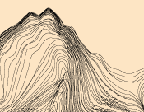
Commissions Available
Marc Tuters and Kazys Varnelis
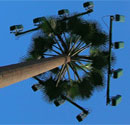
Beyond Locative Media
INTIMATE TRANSACTIONS

Sensing Place Through a Complex Web of Relations
July 06, 2006
URBAN SCREENS 2007

Seeking CURATOR
- Creating a coherent 2-day conference programme;
- Coordinating a range of parallel exhibitions;
- Liaison with venues, partners, artists and institutions;
- Contributing to the documentation of the conference;
- Contributing to the communication and marketing plans for the conference;
- Ensuring access issues and Health and Safety are considered as part of the programme planning process;
- Working within budgets agreed by the Board of Urban Screens Projects Ltd.
- Excellent communication & writing skills;
- Extensive professional knowledge of (audio)visual arts;
- Extensive professional knowledge of the fields of new media & urban studies;
- Fluency in English & preferably one other language.
http://www.networkcultures.org/urbanscreens/
http://www.firstmonday.org/issues/special11_2/
Attn. Dave Moutrey, Director
70 Oxford Street, Manchester, M1 5NH
United Kingdom
Dave.Moutrey[at]cornerhouse.orgArt in the Age of Technological Seduction

CALL FOR PAPERS
[] Paper format and media format are in the 'Submission Guidelines' link
[] Media-N author's agreement is available from the 'Copyright Statement' link
[] Questions: contact guest editors Legier Biederman (lbiederm[at]ucla.edu) and Joshua Callaghan(joshua[at]joshuacallaghan.com)Angels
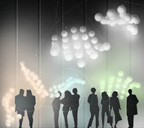
Constructing Reconfigurable Space

Second Life

Hyper-Instruments and Immersive Spaces
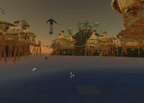
Talking About the Weather
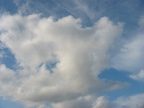
Contribute to Out-of-Sync's Breath Collection
Always ON
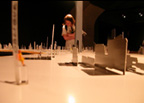
New Augmented Space and its Memory
July 05, 2006
The Paradox of Temporary Centers and the Peripheries they Create
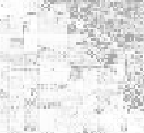
ISEA2006 re:mote Open Call
including voice technologies such as Skype / OpenWengo / Gizmo / Linphone / Ekiga or other softphones, audio or video streams, video conferencing with softwares like ichatAV / Ekiga / Skype / OpenWengo, web cams, shared desktops using softwares like VNC / RemotePC or Remote Desktop, text chats such as irc or webchats, avatar environments, gaming environments, or even the telephone! In situations where your available bandwidth is limited or restricted, delivery of digital presentation material (audio/video) can be delivered electronically or posted by traditional mail. In all situations online presence of the presenters would be beneficial, this may take the form of IM, irc or other text based chat technologies if 'realtime' audio or video communications are not possible. Creative use of remote presentation technologies is encouraged!
Interactive City
Community Domain
Pacific RimVague Terrain 04: The Body Digital
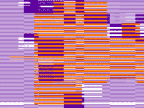
Call for Audio Artists/Musicians
The MagicBook + The Book Radio
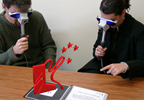
What's New in Books
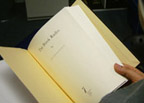
RainDance + A Light Rain
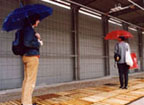
Water Music

Handheld Augmented Reality
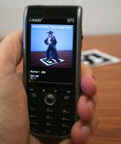
PDA + Studierstube 4.0
Eyeliner

3D Technique Remains a Mystery
Livecoding
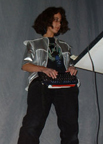
Kinetics of Performance
University of California, San Diego, art professor Amy Alexander performs sets using her own language, Thingee. Alexander says electronic music lacks the kinetic aspects of performance -- seeing a performer do something that has an audible reaction, so she shows crowds her code and enters script commands with guitar-like flourishes. Photo: Courtesy of Amy Alexander [via Wired's Livecoding blog]July 04, 2006
Architecture and Situated Technologies
![]()
Pre-Symposium Discussion
Topics: Networked Public Sphere, Autonomous Uses of Situated Sociable Media
Topics: Performance Paradigms, Responsive Architecture and Artificial Ecologies
Topics: Locative Media, Tactical Urbanism, Situated AestheticsJuly 03, 2006
Music 4100 Computers

Call for 100 Online Performers
Digital Art Weeks 2006
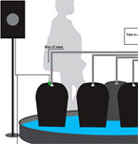
Symposium + Installations
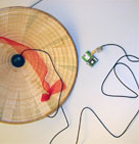
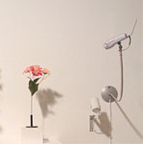
Turbulence Commission
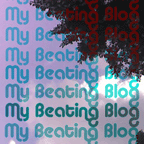
My Beating Blog by Yury Gitman
The Invisible Hand Machine
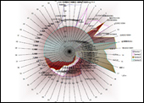
Free Market Harmony Through Excel
State of Play

Life in the Metaverse
